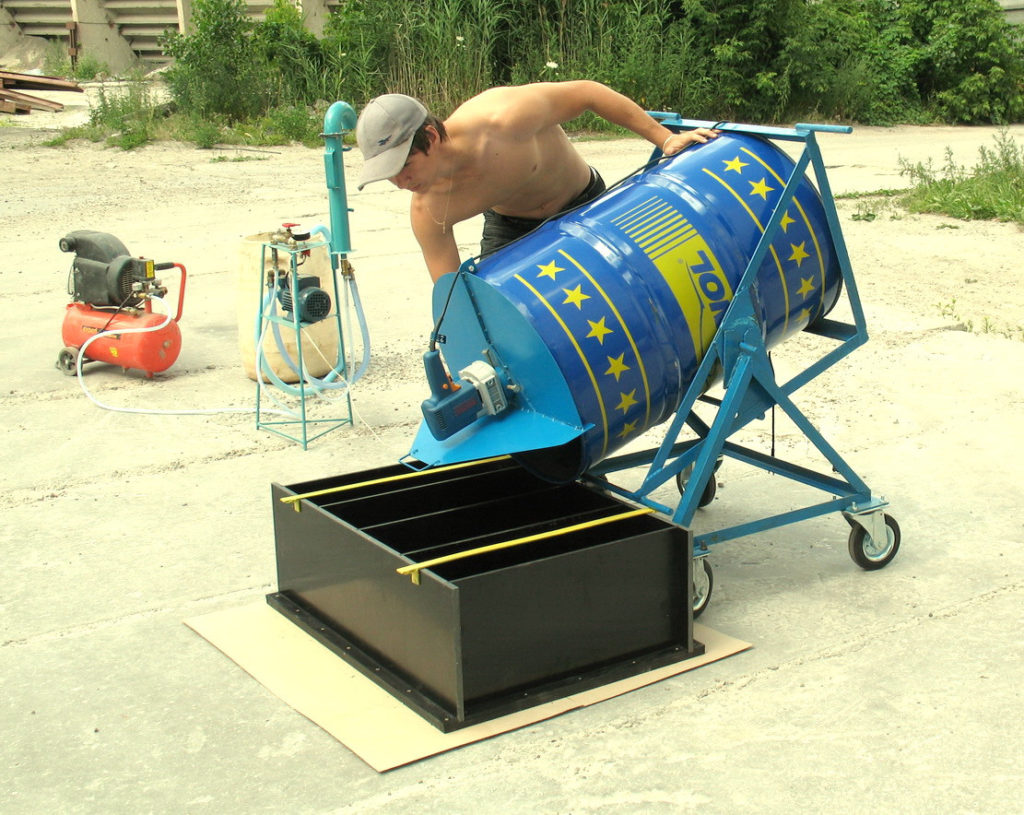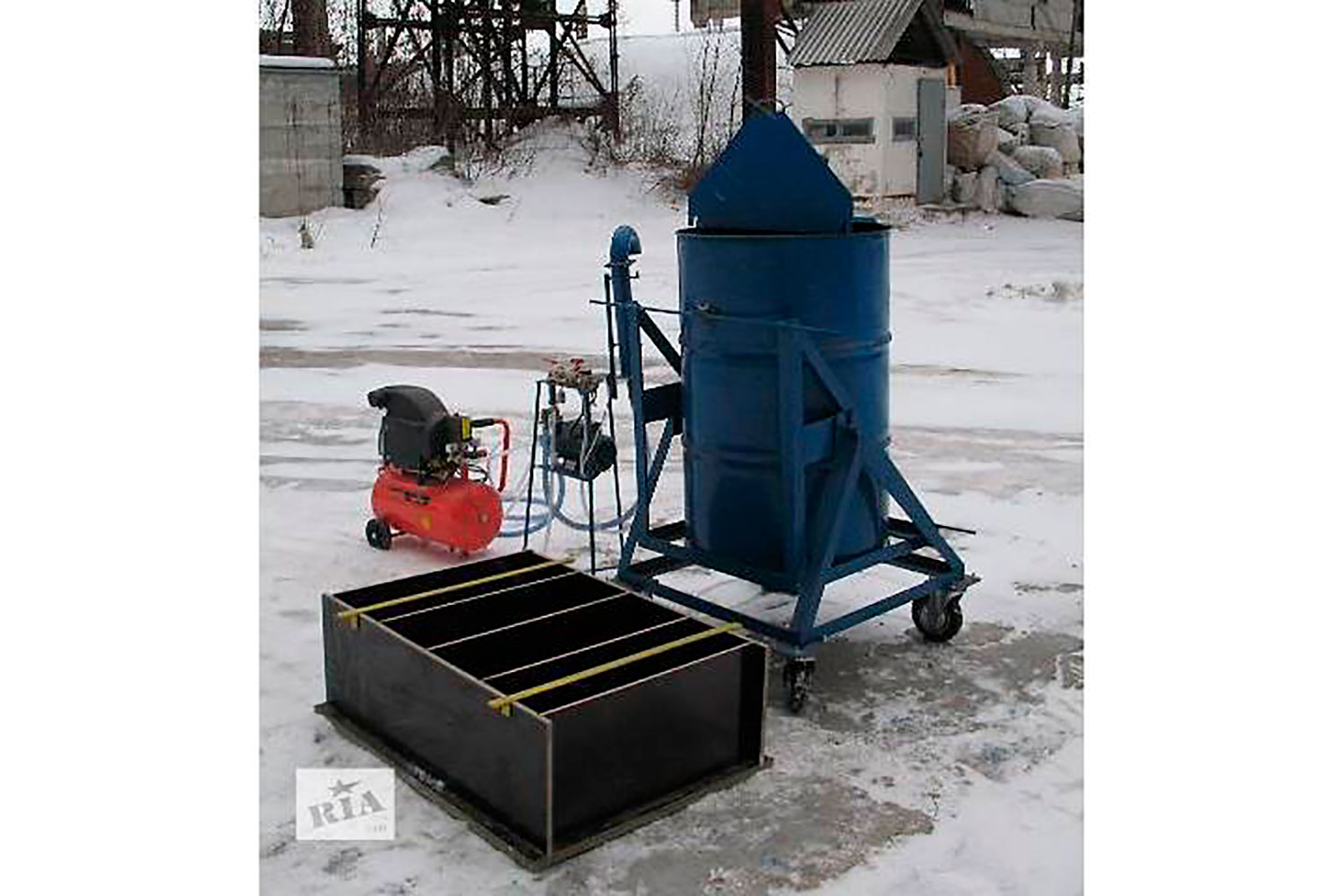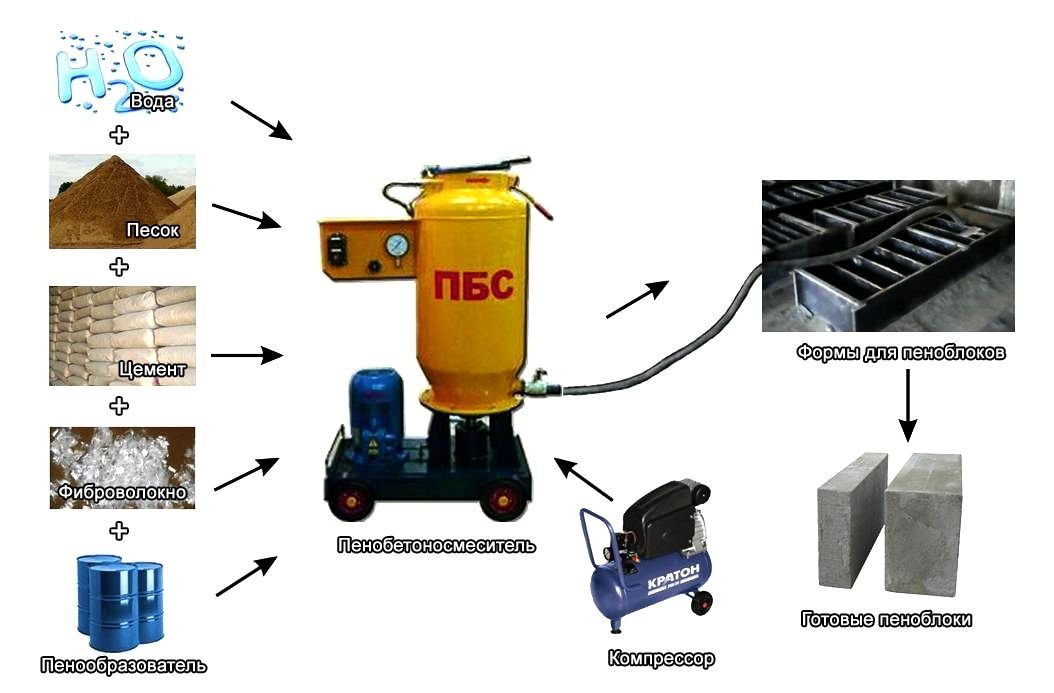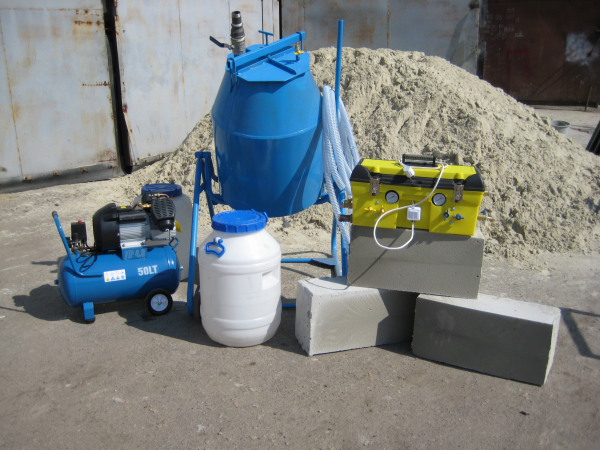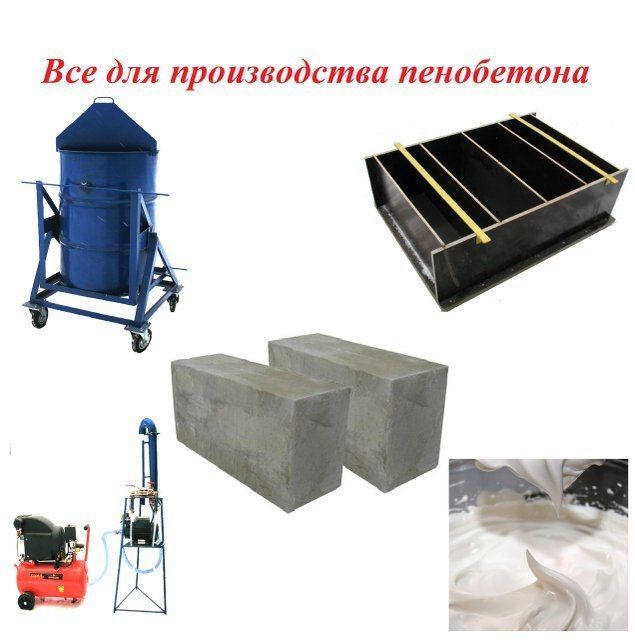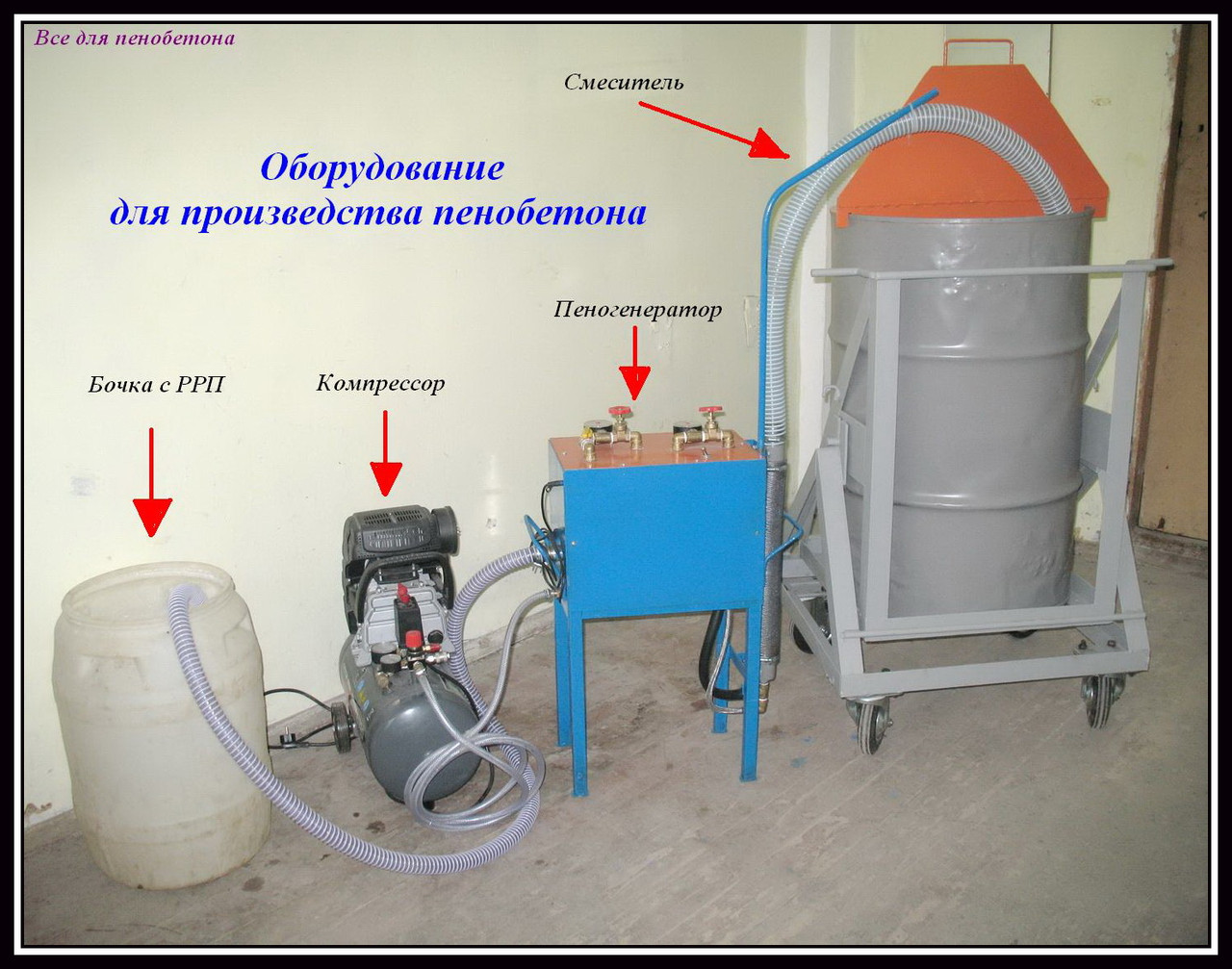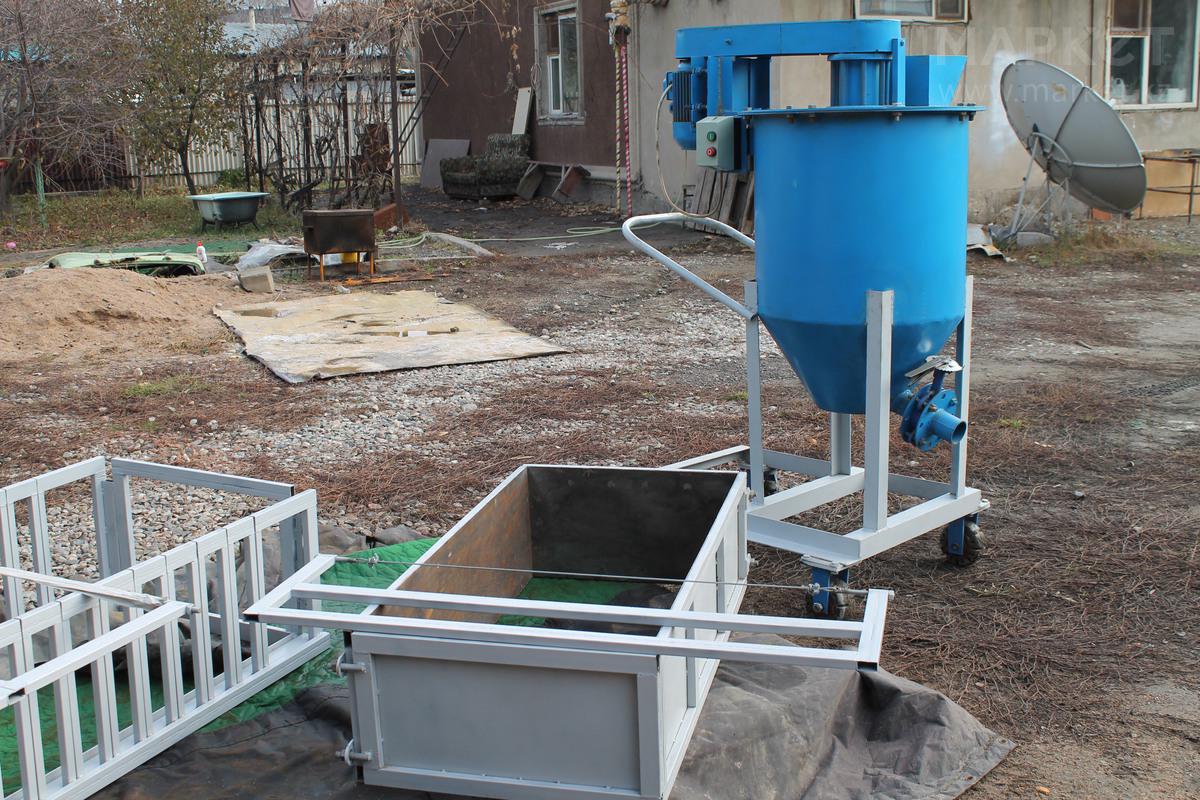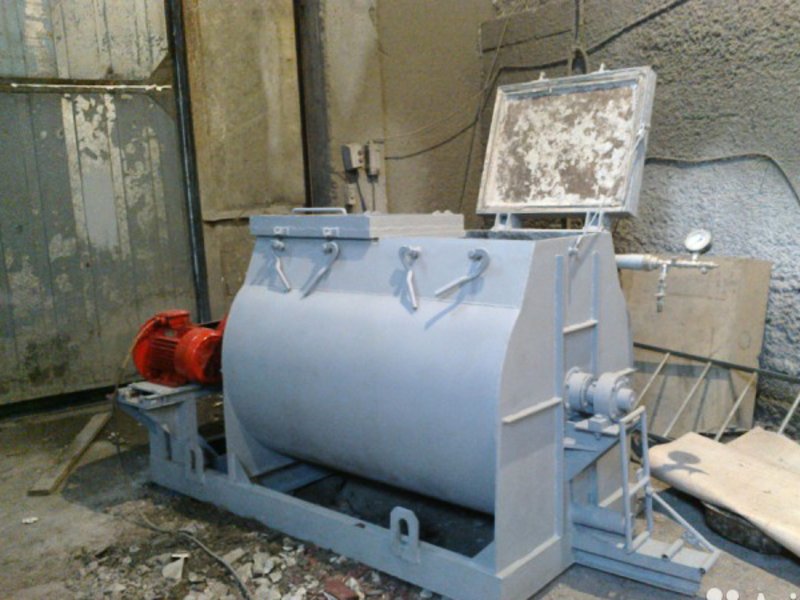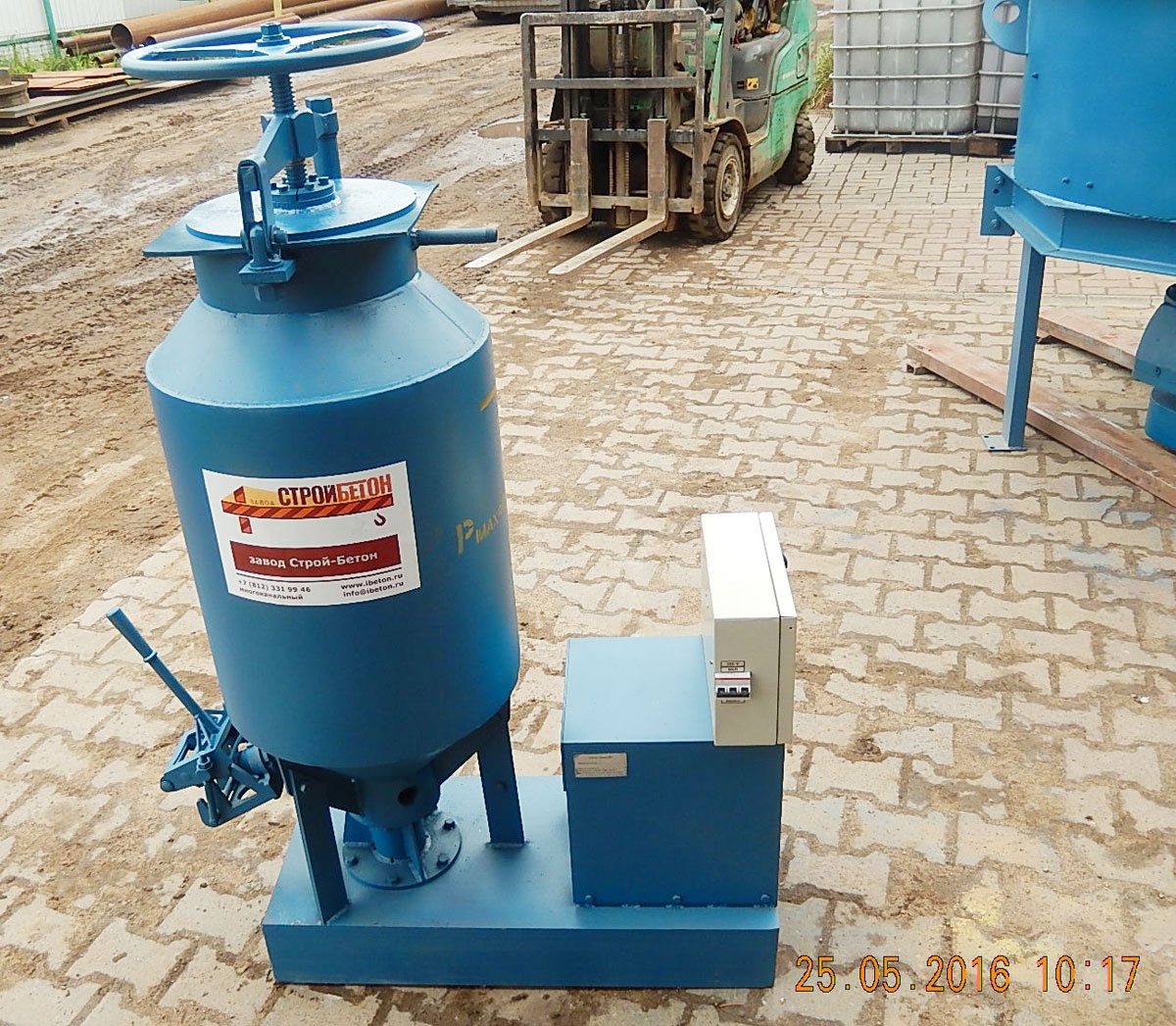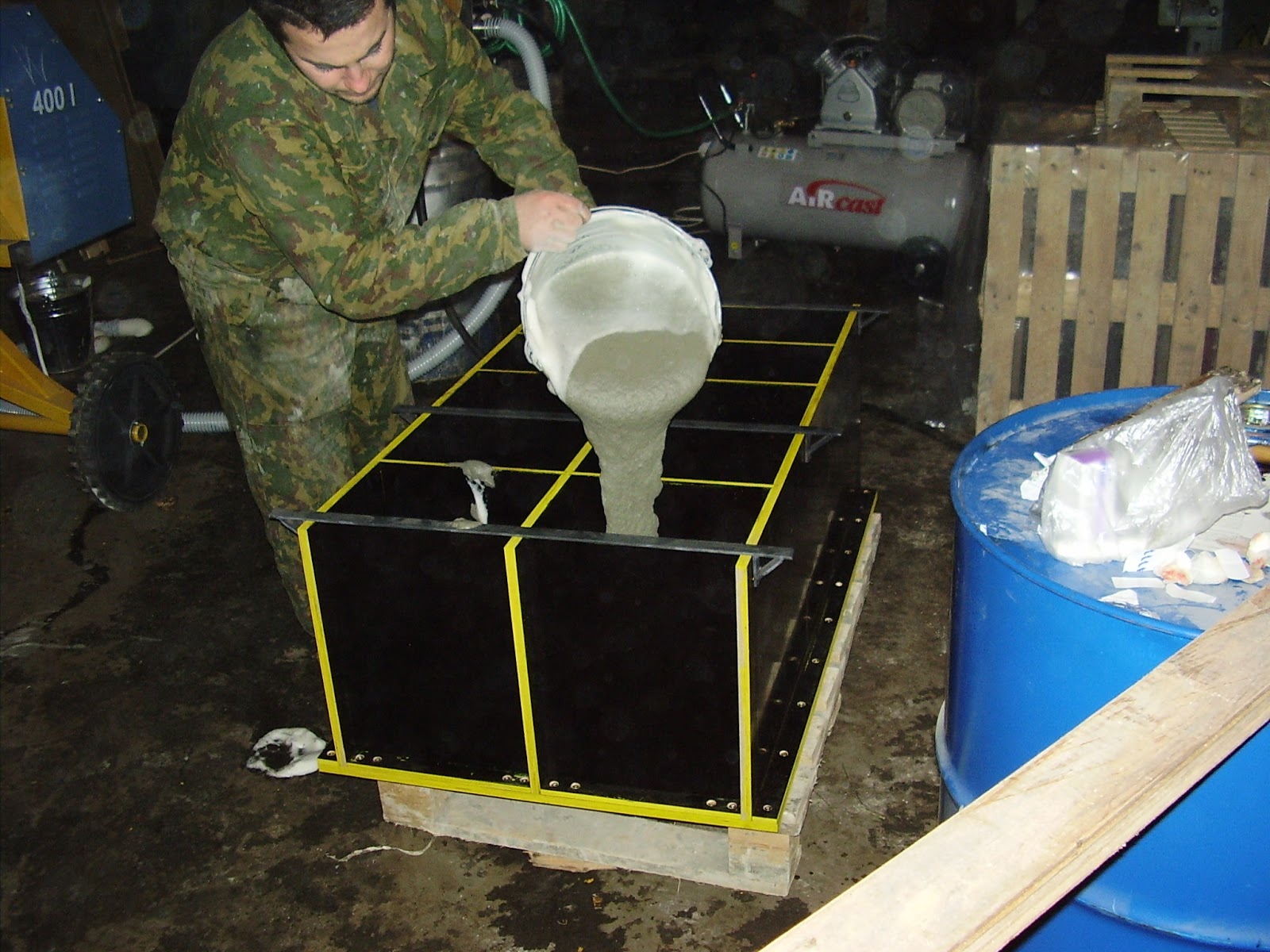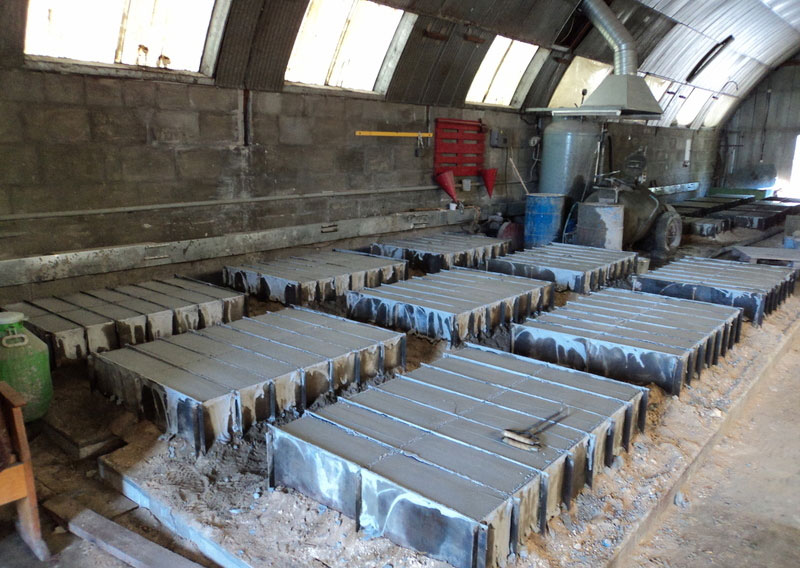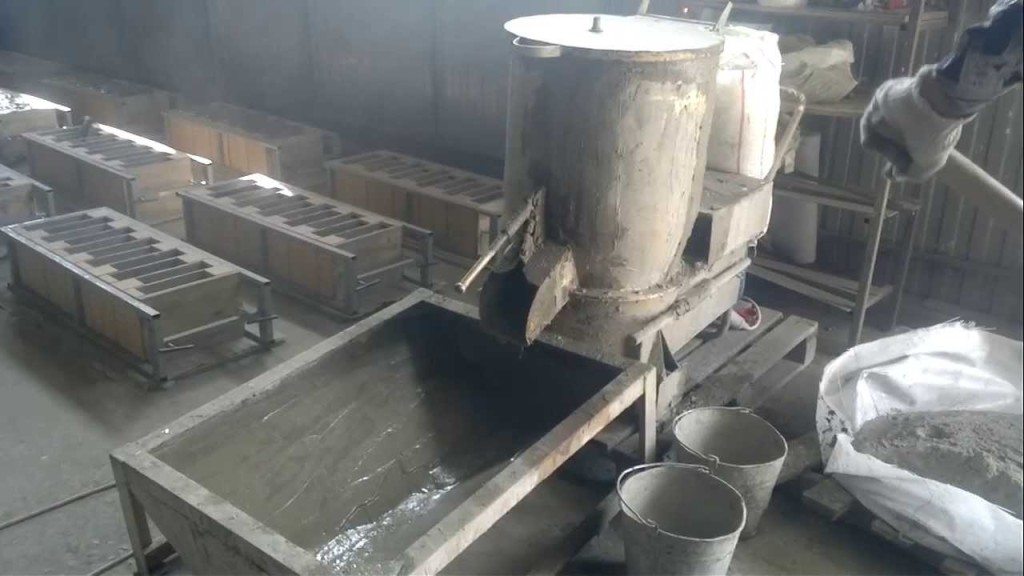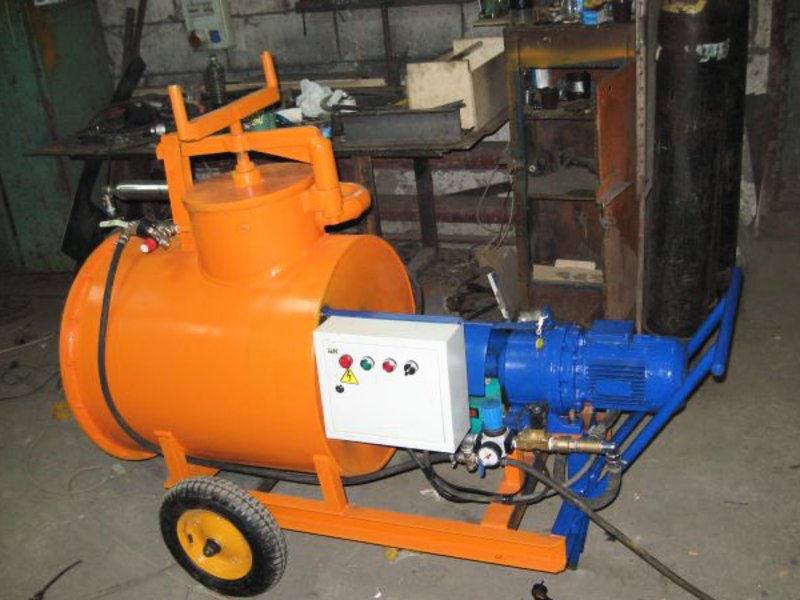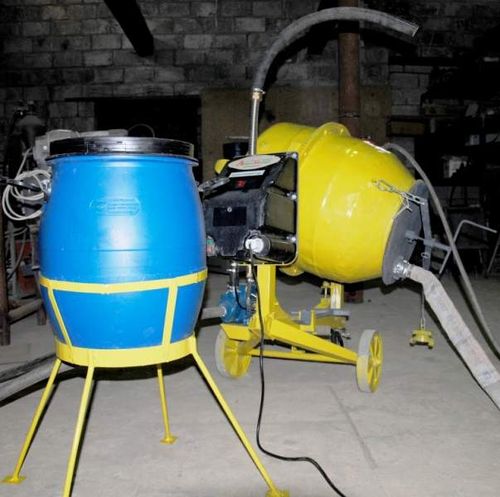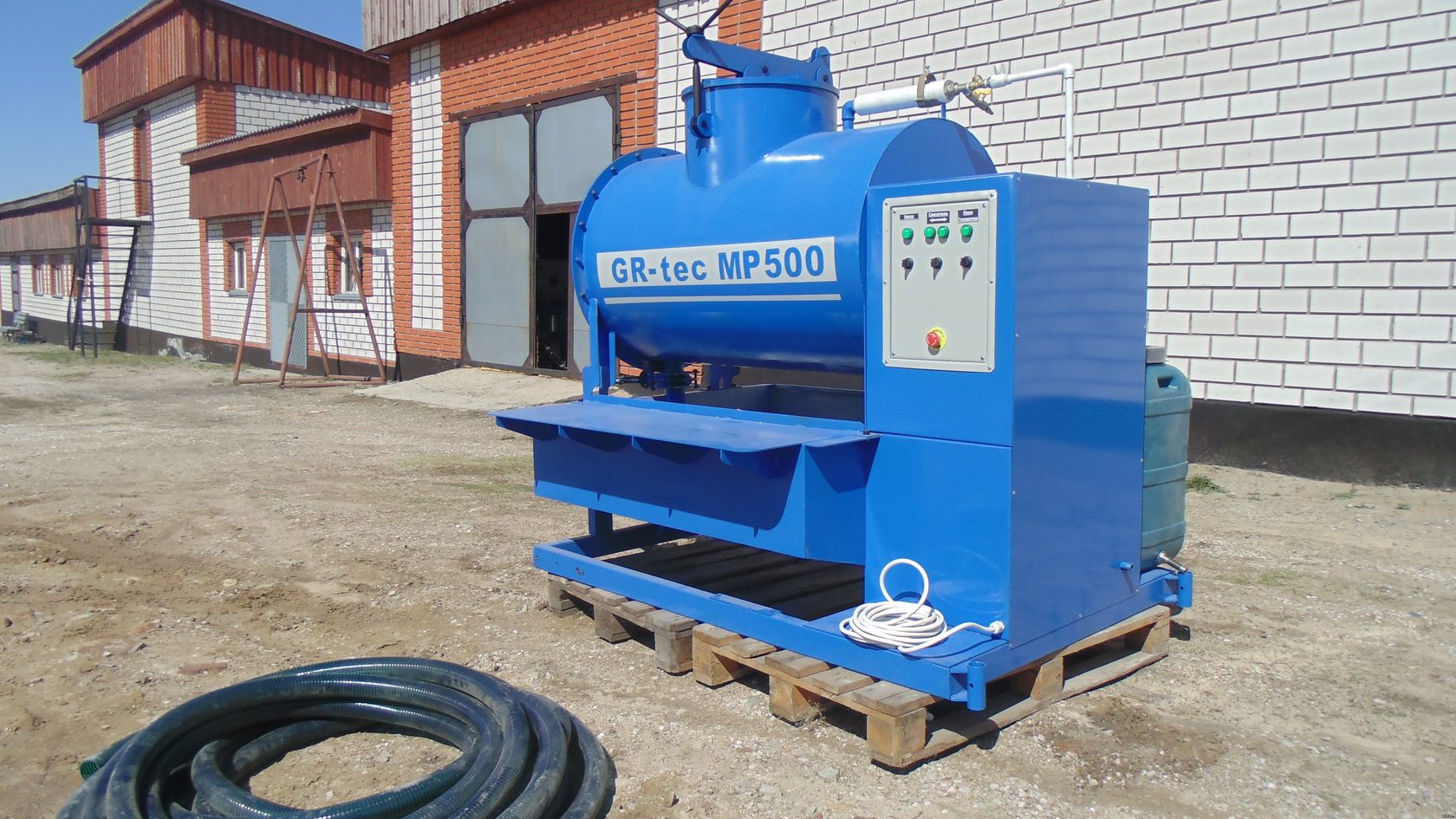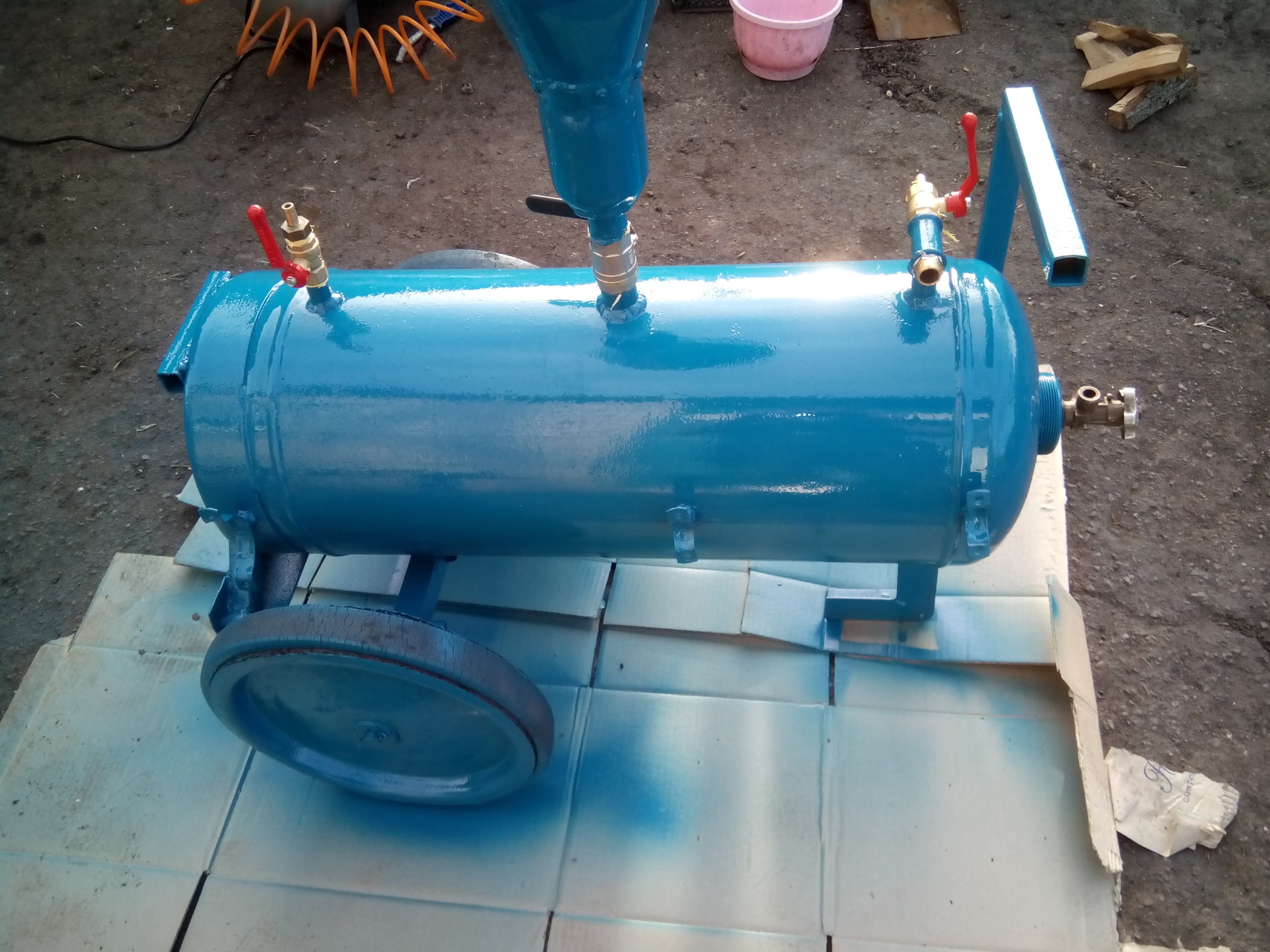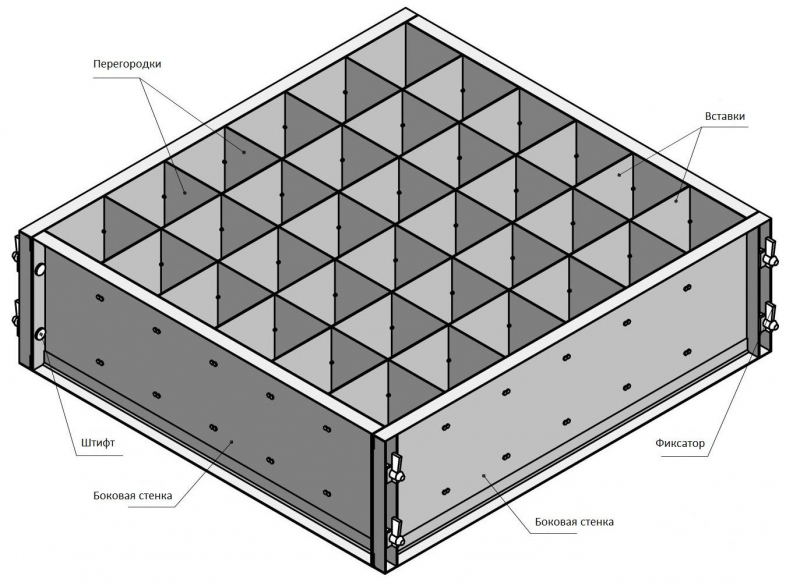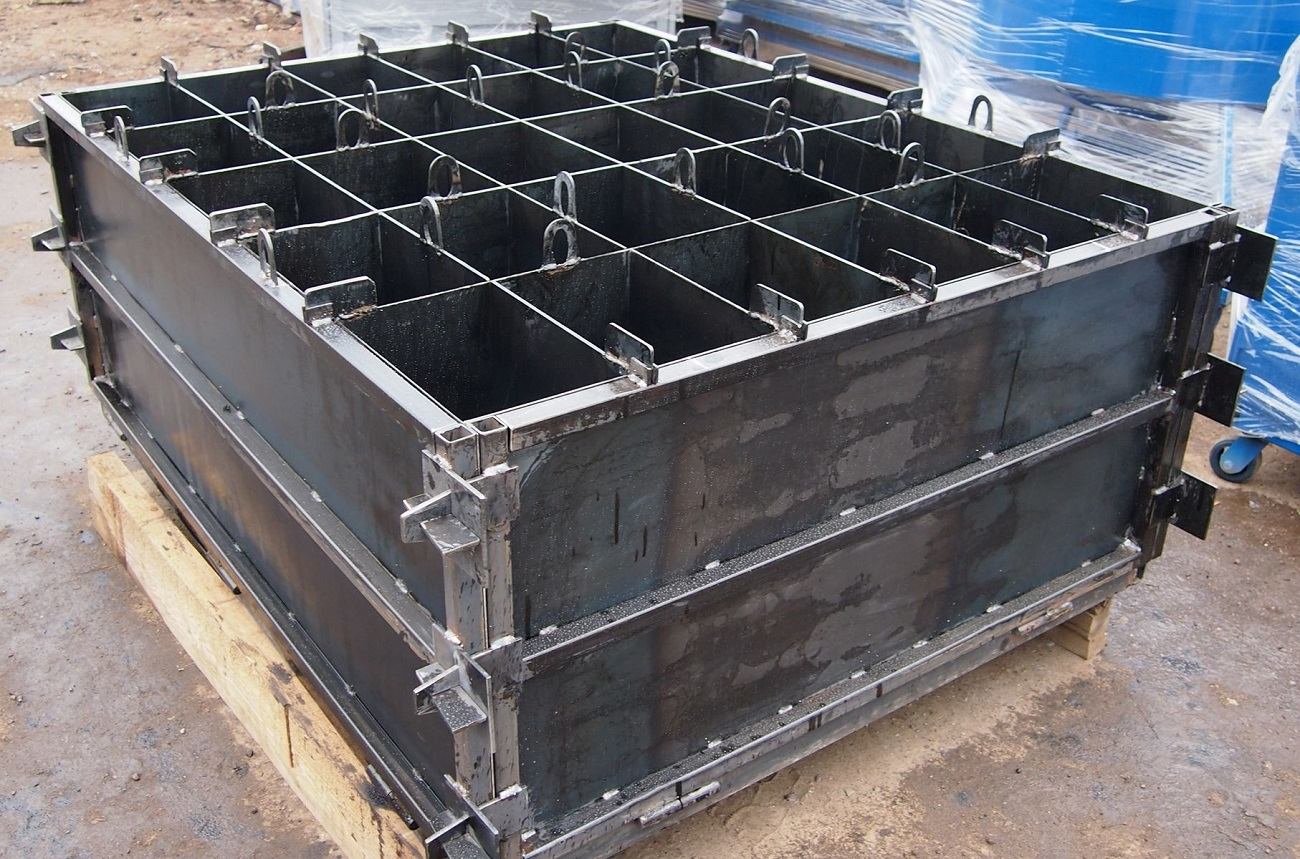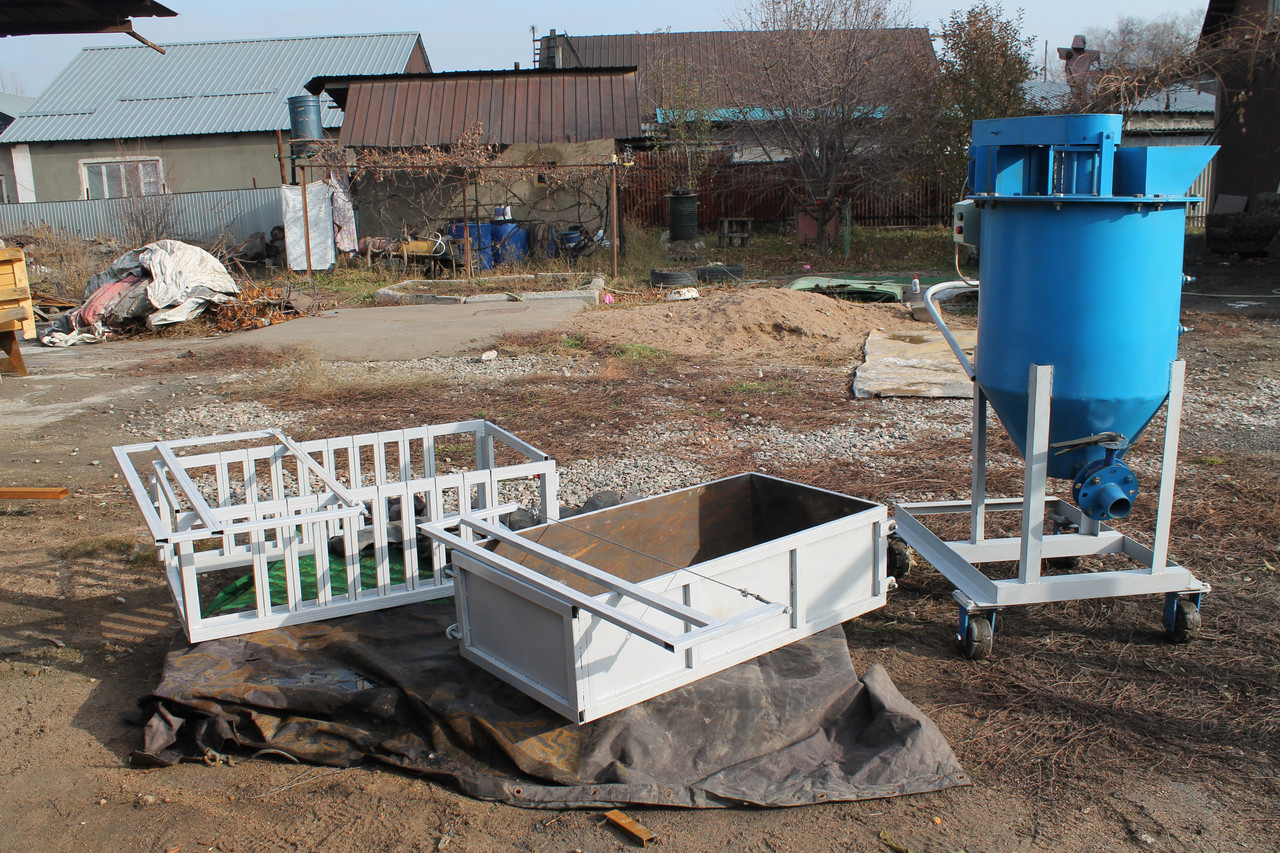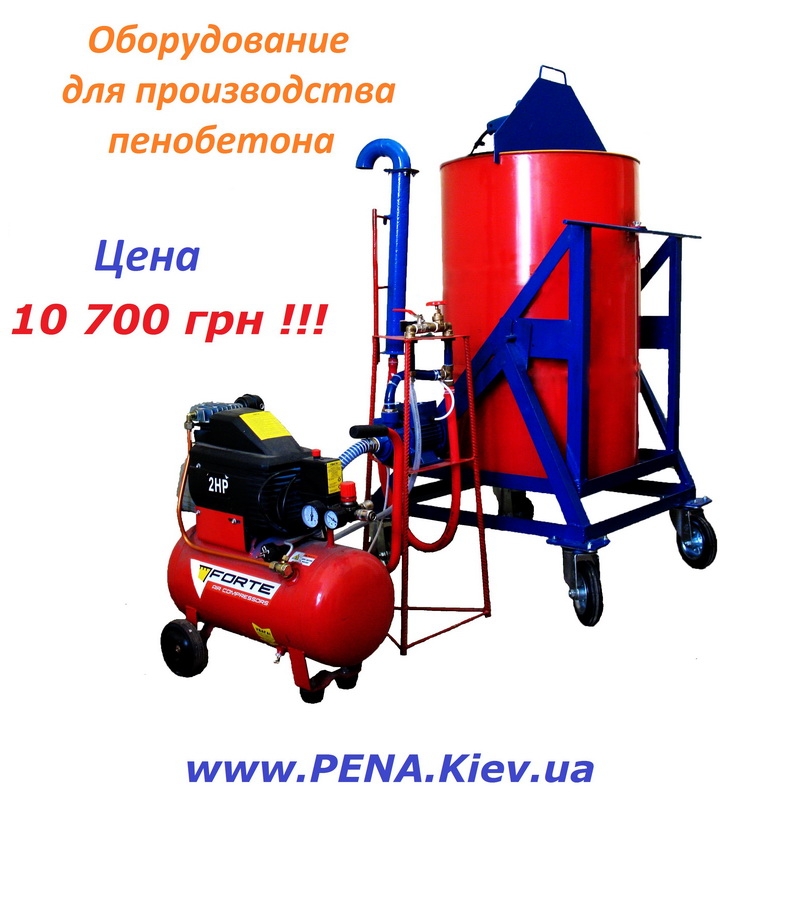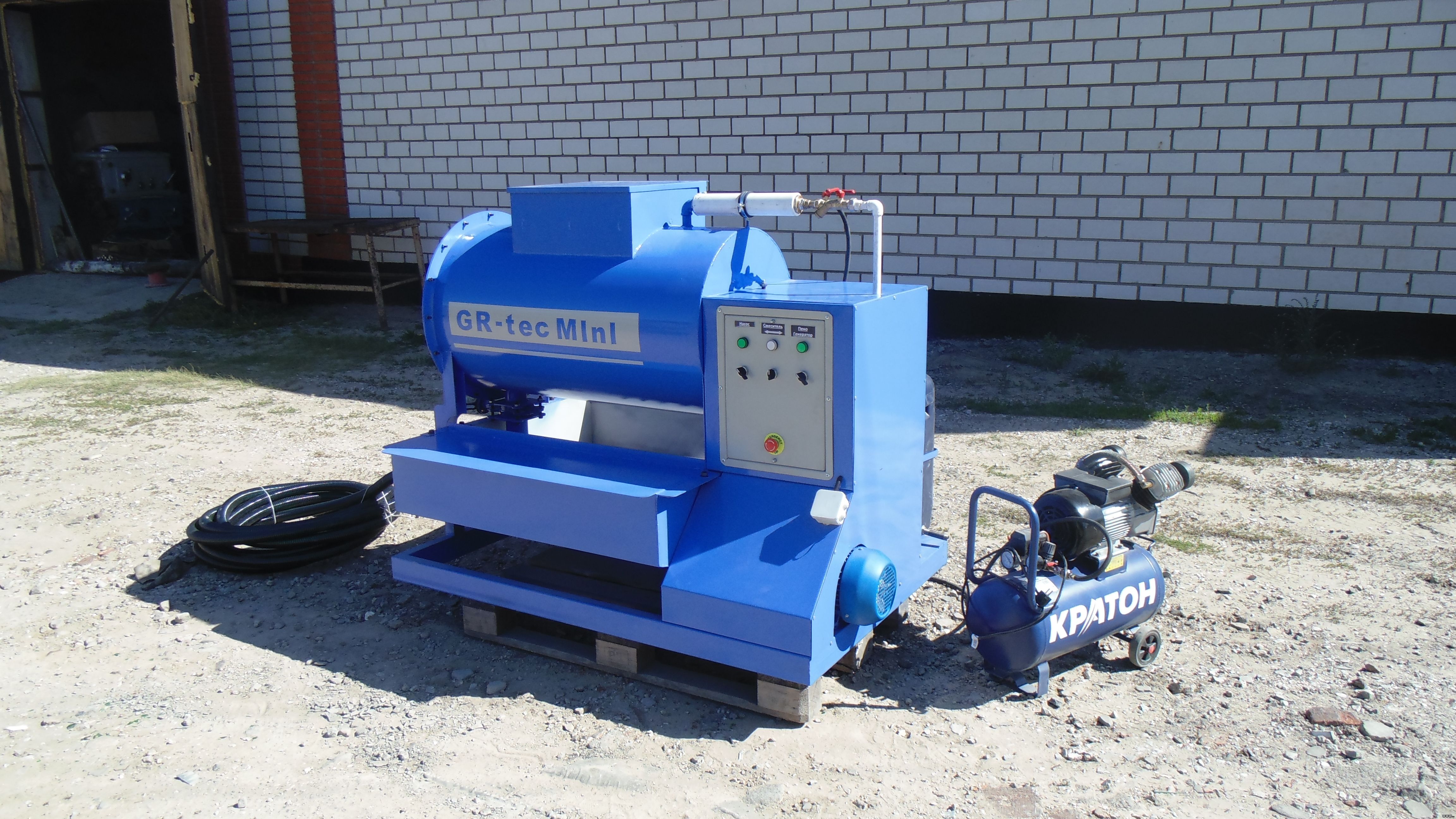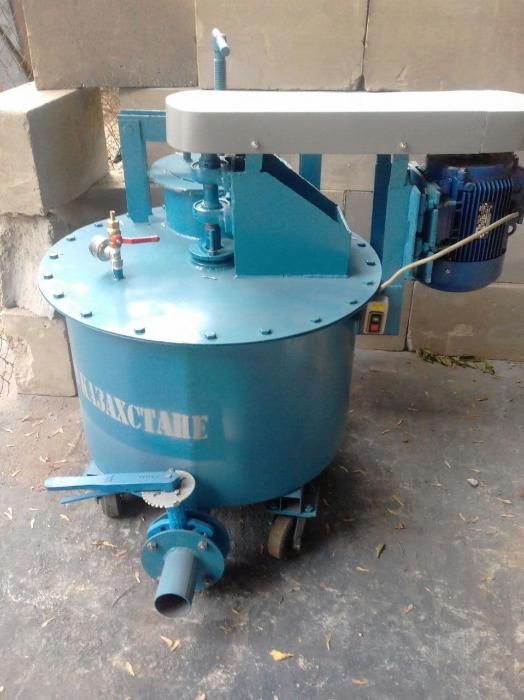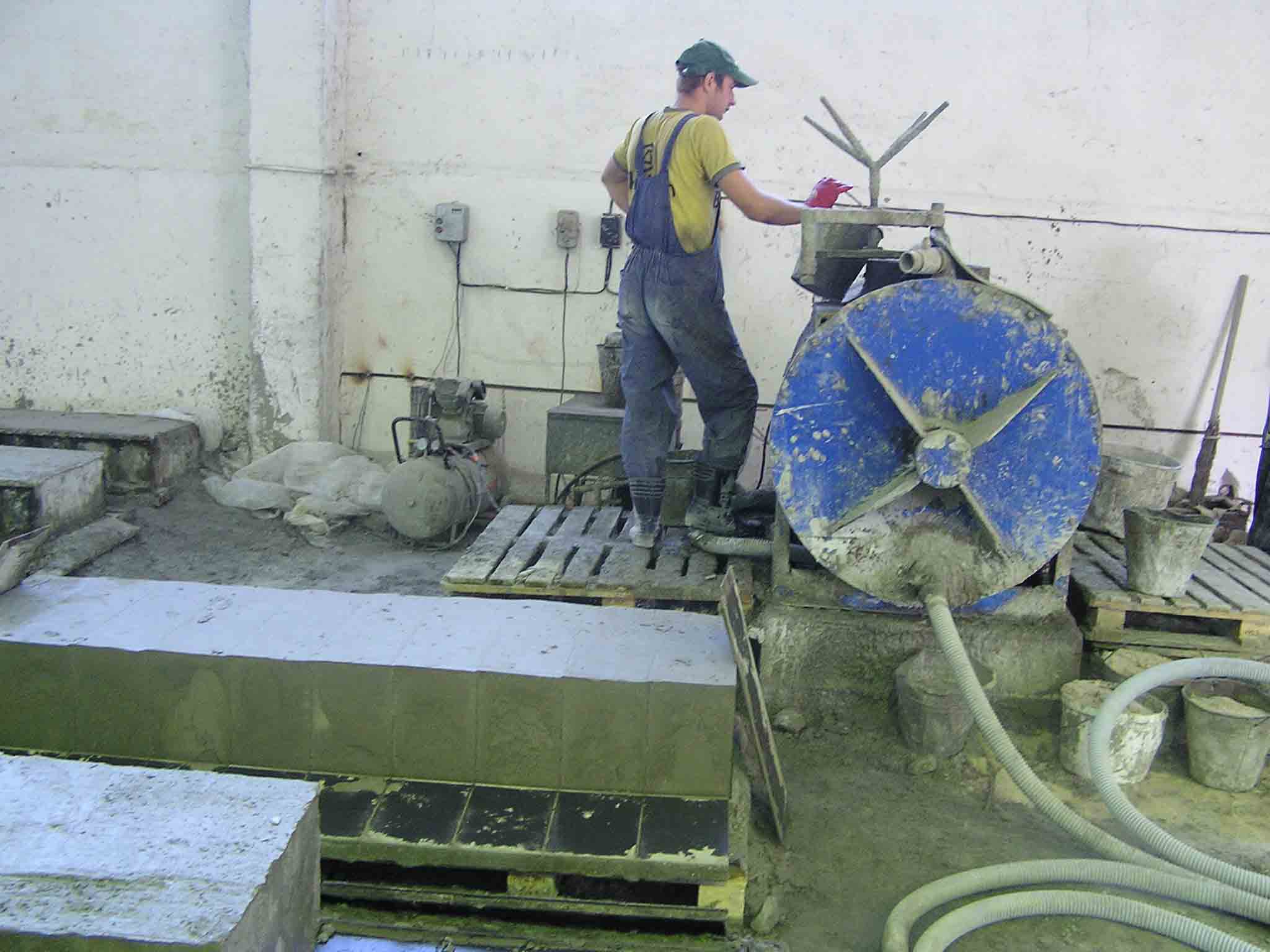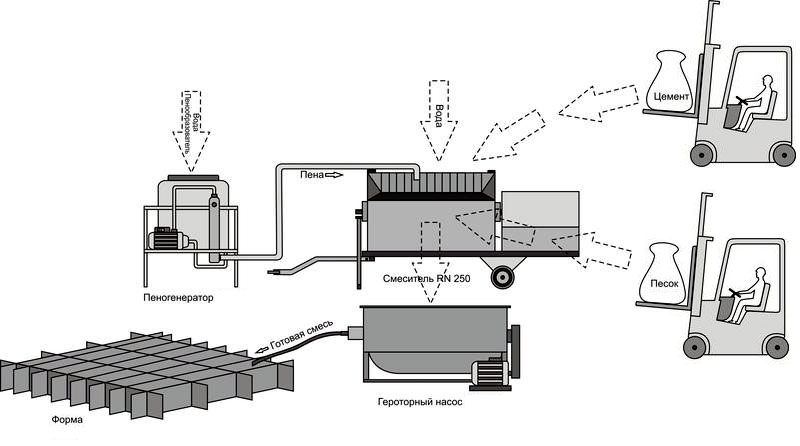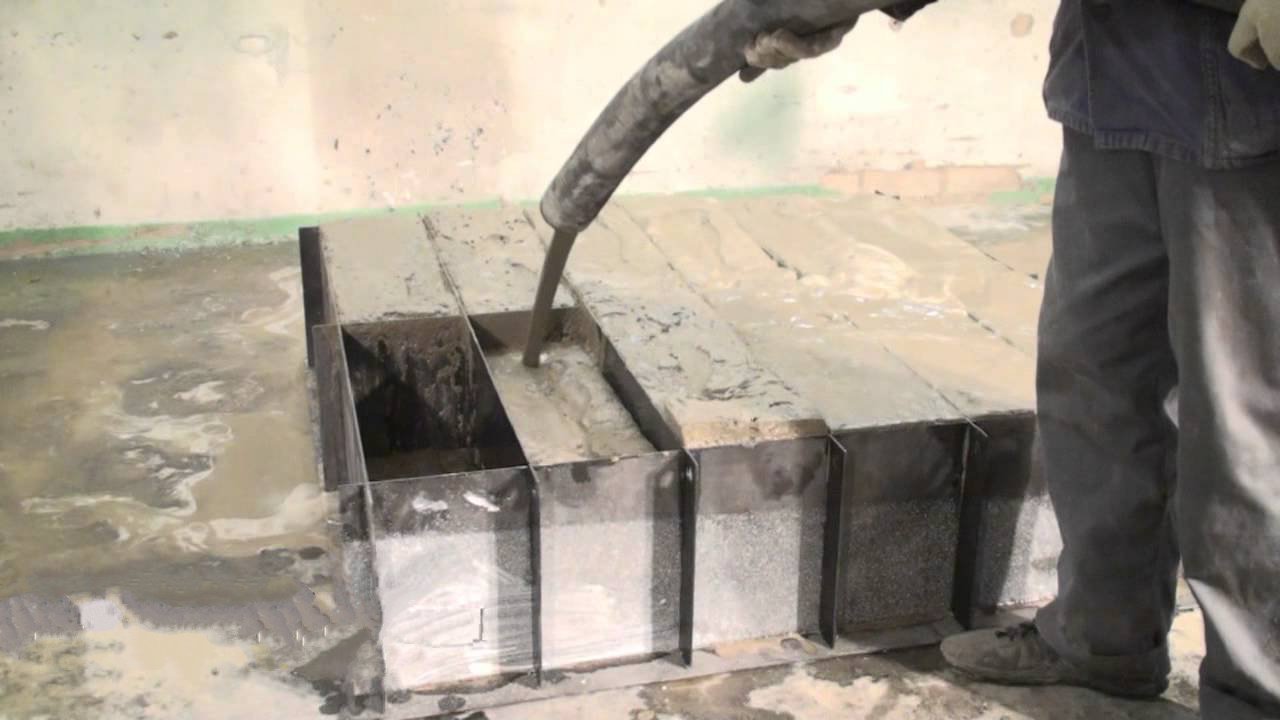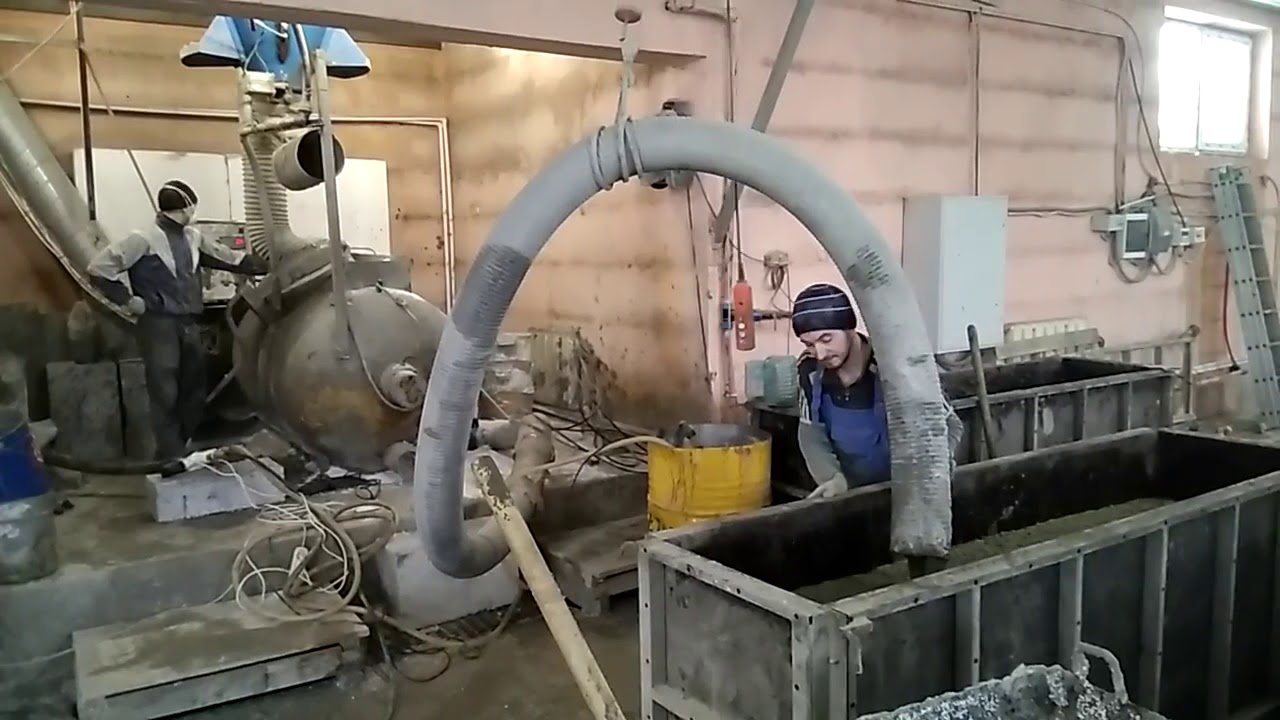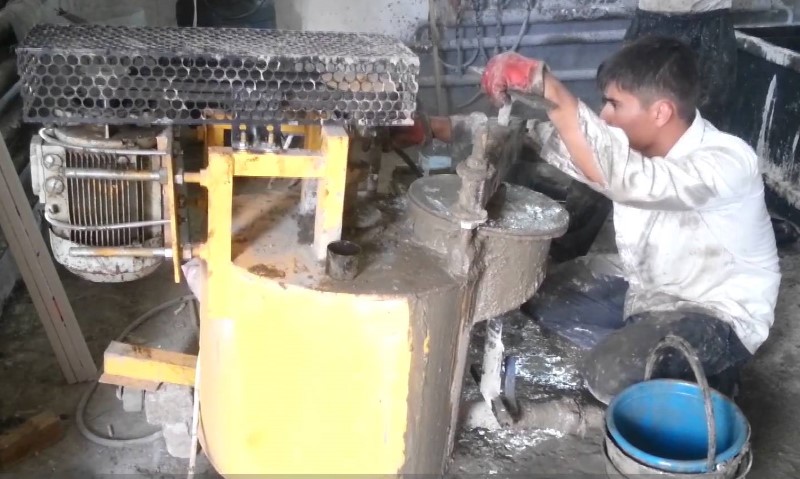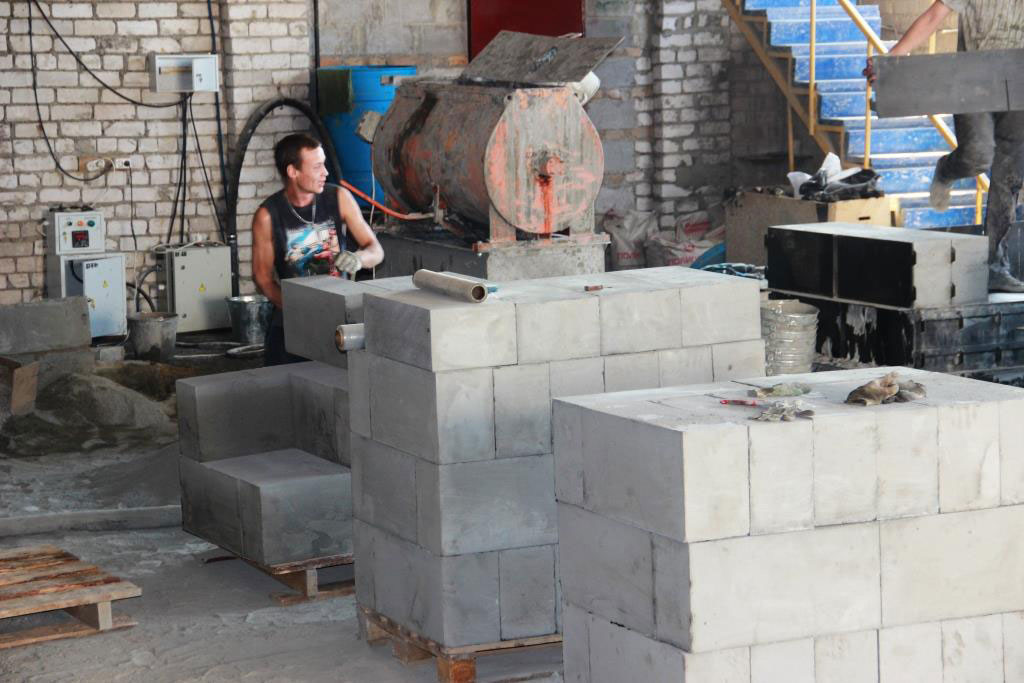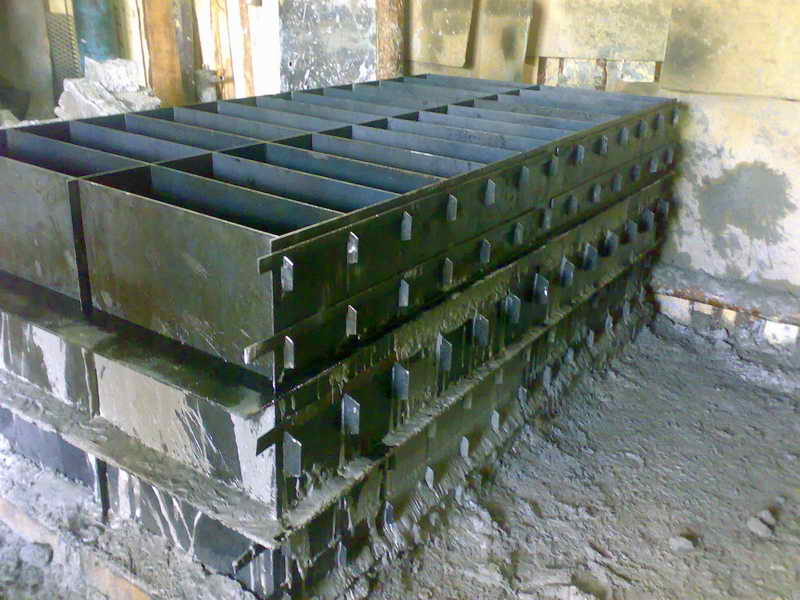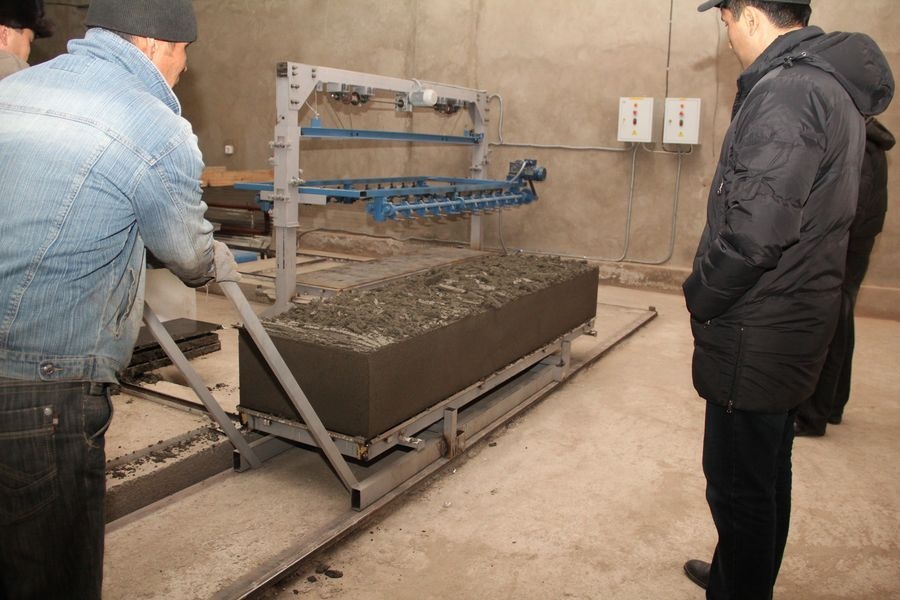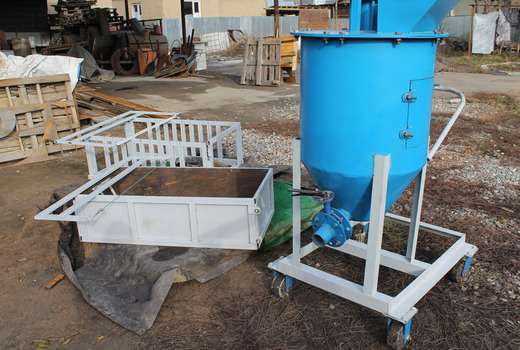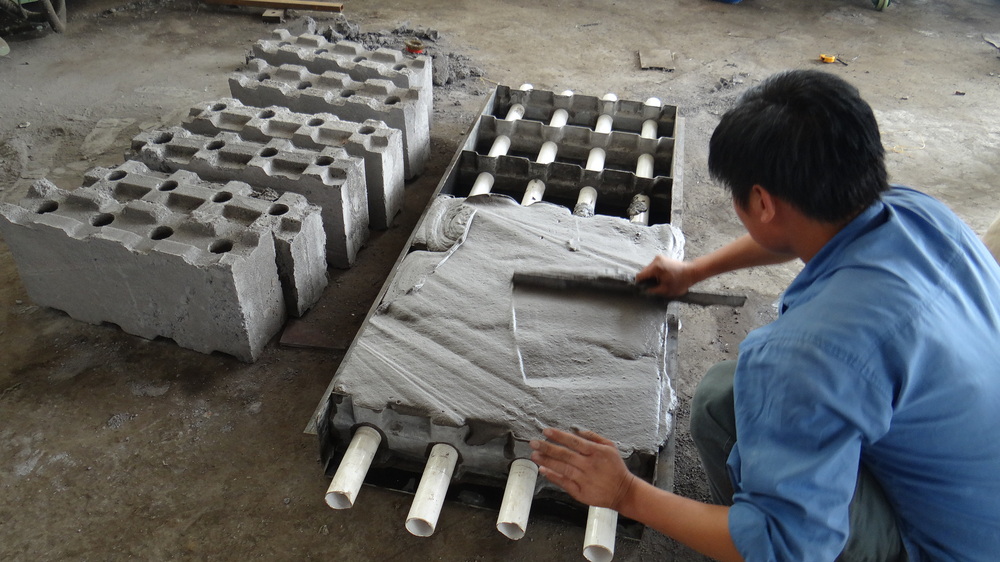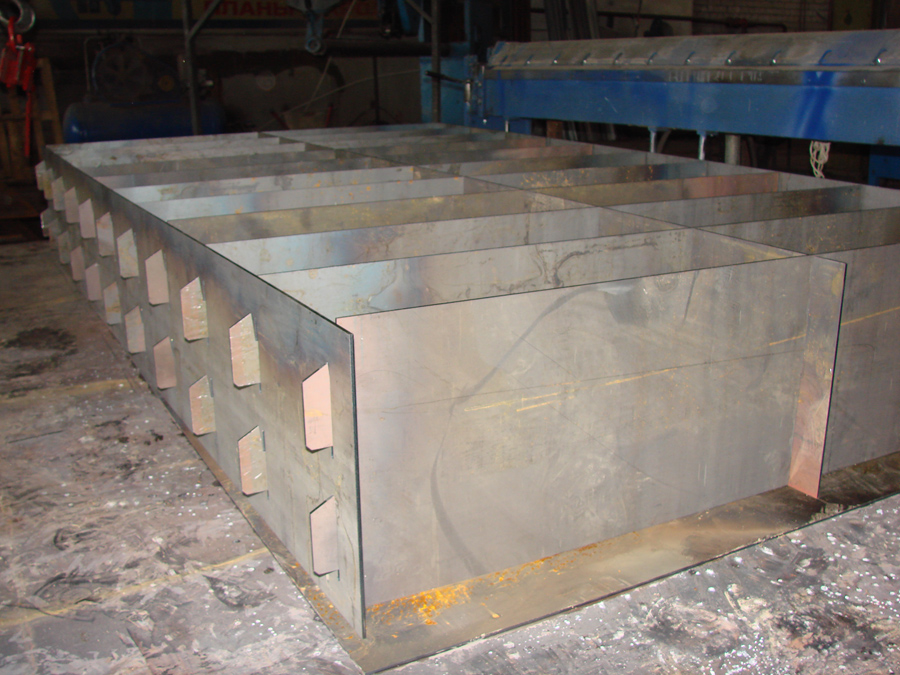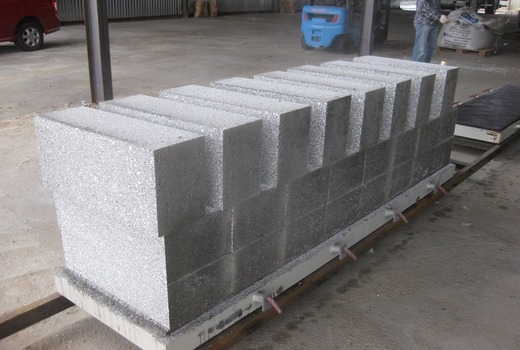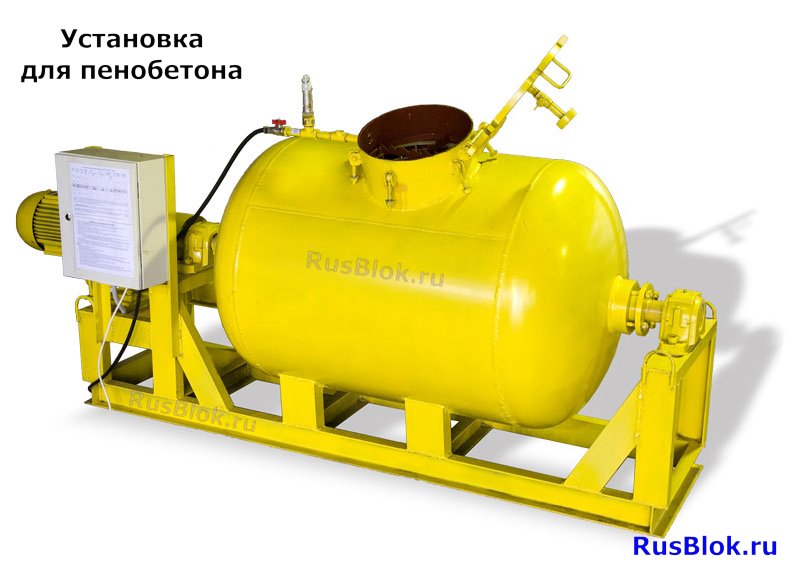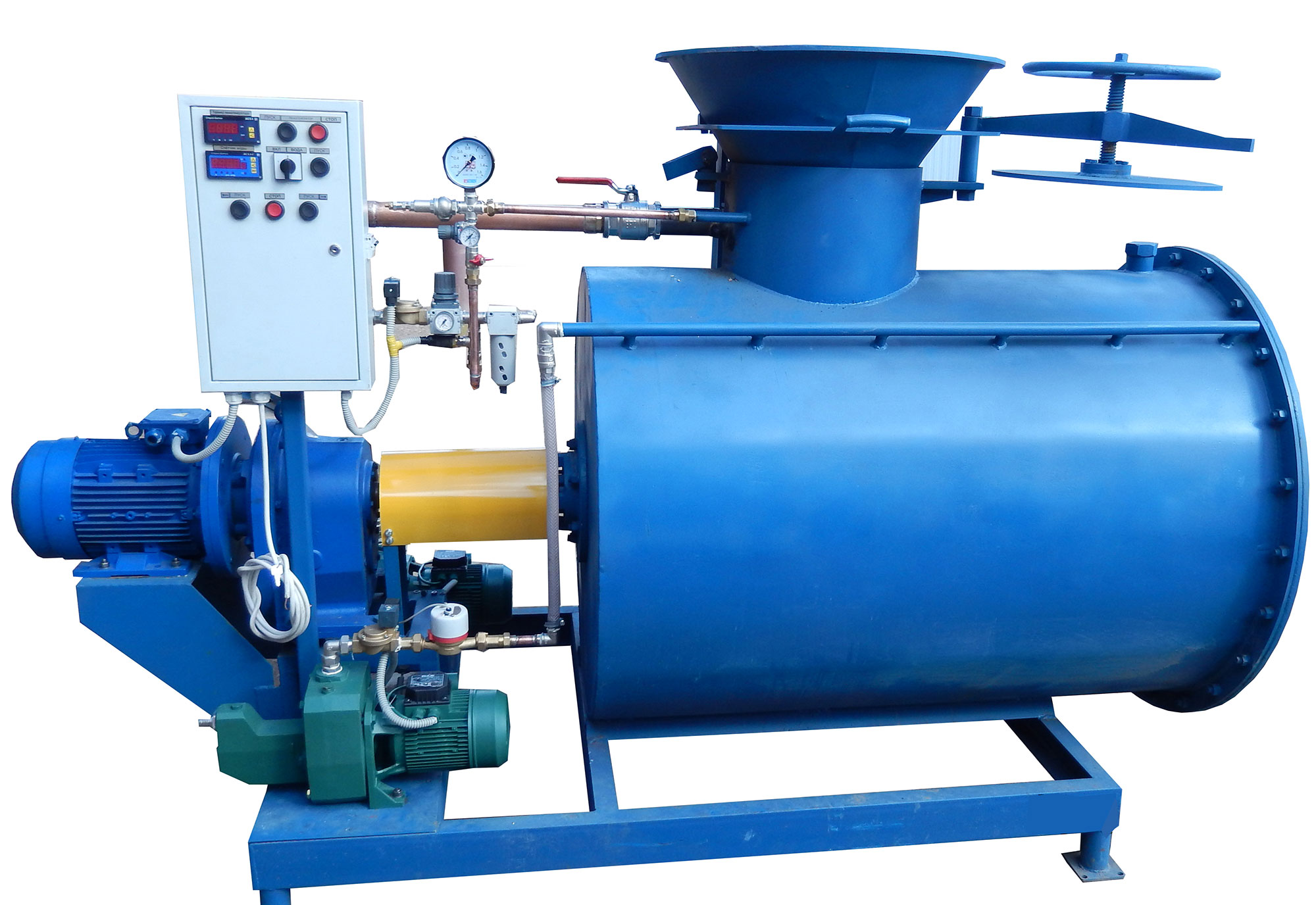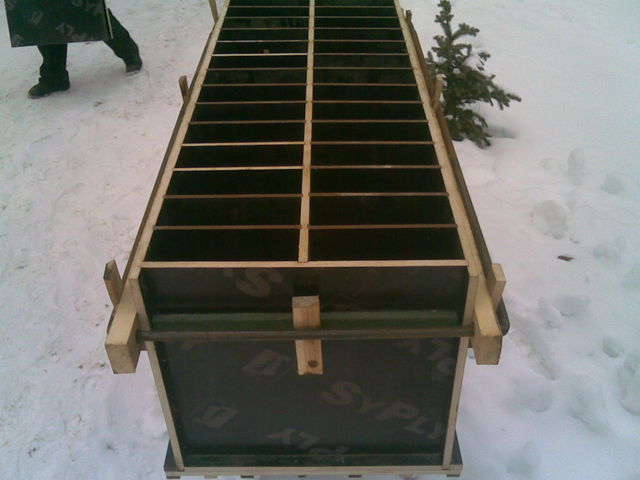About foam block and materials
Today it is not necessary to attract the force of hired workers for the construction of a summer cottage extension.
For example, you can independently:
- make brickwork;
- fill the floors;
- block the roof.
In this case, we will focus on the manufacture of foam blocks, which will be used as the main building material. The price for them is quite affordable, however, if you have the necessary technical knowledge, you have every chance to save even at this stage. The production of foam blocks usually has 300% profitability, and it can be organized without much material investment.

In the photo - the organization of independent production of foam blocks
Foam concrete block is called foam concrete, which is enclosed in a certain shape. Before learning how to make it yourself, you should master the process of producing foam concrete.
Prepare the following materials for work:
- cement M400 and higher, while avoiding any additives in its composition;
- sand, but remember that when making heat-insulating concrete, it is not needed; if a concrete density of 550 kg / m3 or more is required, add crushed or natural sand;
- water;
- foaming agent (add foam to a homogeneous mixture, its density is from 80-85 g / m3: if it is less, the number of pores in the foam block will increase, and this will cause its rapid destruction;
- special equipment.
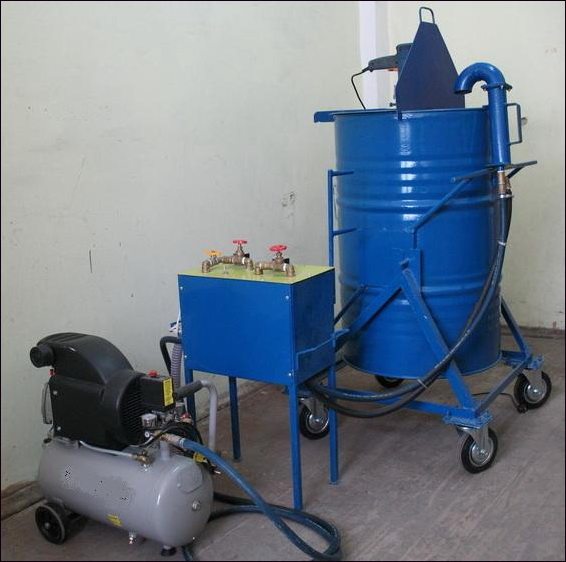
Equipment for the production of foam concrete at home
Technology
| Materials for 1 m3 of foam concrete | Sand ≈ 220 kg; cement - 350 kg; foaming agent - 1-1.5 l; water in the required amount. |
| Equipment | 1. Foam generator. 2. Compressor. 3. Concrete mixer. 4. Forms for foam blocks. |
If you think that you need a lot of materials to make foam concrete, we hasten to please you, the costs will be much lower than when buying branded foam blocks. Cement is the most expensive; other components are only a quarter of the total cost.
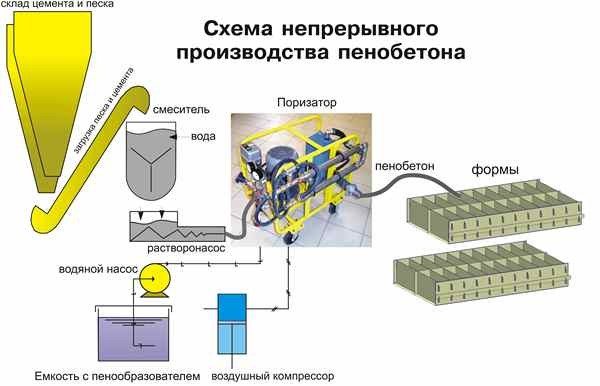
Continuous foam concrete production technology
Agree, the picture is quite interesting, but you should also take into account the difficulties that may arise in the production of foam concrete blocks, which may entail additional costs. It is also necessary to calculate the cost of special equipment, as well as the fact that you will be making foam concrete for the first time. There is also a high probability that the first time you will not be able to achieve the required quality of the solution.
Pay special attention to the forms, since the future appearance of the foam blocks and their overall dimensions will depend on them. Among them, the main parameter is the width, since it affects the thickness of the masonry.
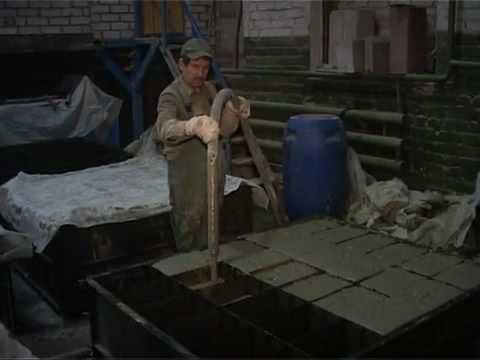
Production of blocks from foam concrete by pouring into molds
If you decide to build a garage - 200 mm is enough; when building a house, it cannot be less than 300 mm. You can make the necessary equipment yourself or buy it in a retail network.
It should be said right away that the purchased device sometimes may not suit you for a number of characteristics, then you will have to modify it yourself. The easiest way is to make molds for foam concrete blocks using any material, but it must have 2 main qualities - evenness and maintain dimensions under the weight of concrete.
Making forms
They should be cells in a large box with dimensions corresponding to the dimensions of the future block.
You can make them from:
- metal;
- plywood;
- boards.
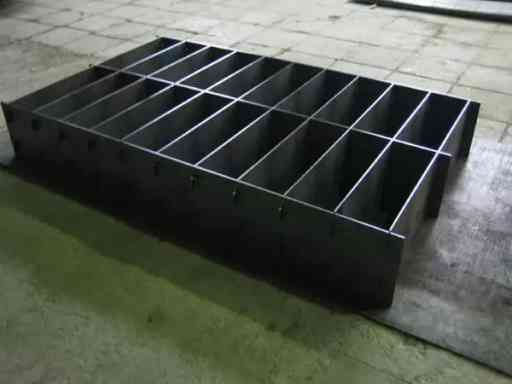
Metal form
The main advantage of self-production of foam blocks is the arbitrary shape and size of the finished product. For the construction of a house, products with dimensions of 600x300x300 mm are suitable, although you can use others, but you should obey the rule - the length should be a multiple of the width or height.
An example of a plywood mold
- Cut out the bottom from the plywood sheet, the dimensions of which correspond to the length and width of the box.
- We also make its outer walls.
- We knock down 5 plywood blanks so that they resemble a box. Moreover, its dimensions must be made a little more than a multiple of the length and width of the numbers. This is due to the thickness of the partitions, which should also be taken into account.
For example, with a length of 1500 mm, 5 blocks and 4 partitions between them will fit in the box. The width of the form is also calculated.
- Install the dividers into the finished drawer and secure with nails.
- Wrap polyethylene upholstery before filling the mold with concrete. This will protect the plywood from moisture, and the finished block will be easier to get out of the cell, even without disassembling it. For independent work, it is enough to make about 60 or fewer cells.
2 Equipment for the production of foam blocks - what is required?
Foam concrete is produced at home using a simple technology. For its implementation, the following devices and units are used:
- foam generator;
- compressor;
- concrete mixer;
- pump;
- forms.
The foam generator can be made by hand. The principle of operation of such devices is elementary. The foam concentrate mixture is directed to the mixing compartment at a 90-degree angle, where it is mixed with the air flow. The pressure force begins to act on the solution. The mixture is fed into a special nozzle (it has a truncated shape). In it, the composition first contracts and then expands. Then the solution is squeezed out under pressure into a special cartridge, where the foam is obtained.
To make a home-made generator, you need to purchase and connect in series (using couplings) such elements - shut-off and control valves for supplying air and mixture, a mixing chamber, a truncated nozzle (in stores it is sold under the name Laval device) with a diameter of 1 cm, a foam cartridge. You will also need a nozzle with a mesh washer and thread. Some craftsmen use a jet washer instead of a Laval nozzle. But it is better not to do this, since the efficiency of the foam generator can decrease by 20–40%.
A homemade foam unit is powered by a compressor. You will need a device that provides a pressure of about 5.5-6 atmospheres, with a capacity of at least 0.5 cubic meters per hour. It is allowed to prepare the foam concentrate directly in a separate container with a capacity of 150-200 liters. The mixture is supplied to the generator using any domestic pump.
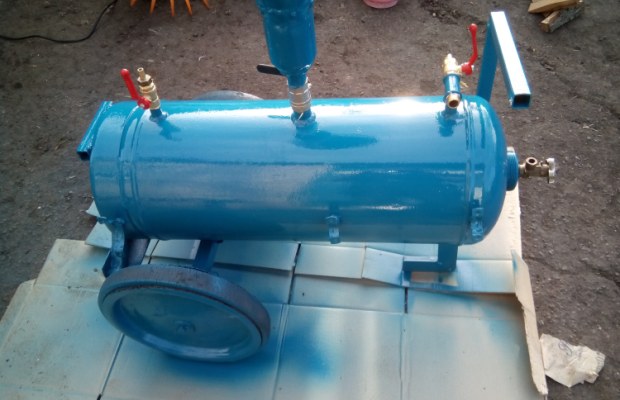
The foam generator can be purchased at any hardware store
If you don't want to bother with a homemade steam generator, you can buy it at a specialized building store. The cost of such equipment is relatively affordable. But it makes sense to do the forms yourself. They can be made from sheets of moisture-resistant plywood, which must be covered with a metal frame, or from metal sheets about 3.5 cm thick. The shape is an ordinary box of the size you need. Decide in advance how many blocks you plan to make in one work shift. Based on this, shoot down the required number of forms. Their reuse is not allowed.
Foam blocks production technology at home
The technology for the production of foam blocks at home provides for the following work:
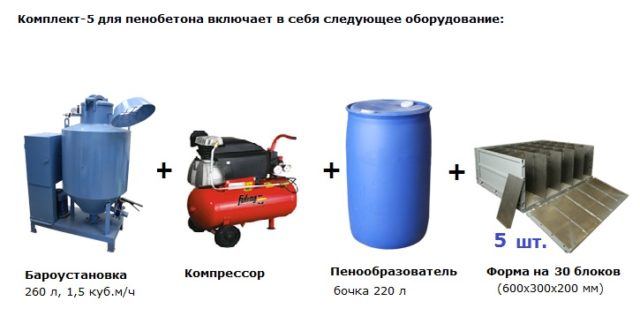 The longer the composition is kneaded, the more the foam is destroyed, which is unacceptable, since it is fraught with a significant decrease in the strength and other characteristics of the finished foam concrete
The longer the composition is kneaded, the more the foam is destroyed, which is unacceptable, since it is fraught with a significant decrease in the strength and other characteristics of the finished foam concrete
- Preparation of the starting components in quantities corresponding to the recipe.
- Preparation of the required volume of foaming agent from the foam concentrate.
- Mixing cement-sand mortar in a concrete mixer.
- Adding water and introducing foam, followed by mixing.
- Pouring foam concrete mixture into molding containers.
- Deposition of finished blocks in containers.
- Removing products from molds for further drying.
Production of a prefabricated form for foam blocks
Making a molding box for pouring foam blocks with your own hands provides an opportunity not to be limited by the standard dimensions of products. When designing a molding container, one should take into account the number of blocks that will be poured at one time.
The following materials are used to make the mold:
- moisture resistant plywood;
- a metal sheet;
- planed boards.
The manufacturing process of the molding container is simple:
- Prepare a working drawing or a sketch of the mold box.
- Transfer the sketch dimensions to the material you are using.
- Cut the side and cross pieces to the required dimensions.
- Cut out the bottom of the forming container.
After making the individual elements, assemble the mold. When using plywood, place polyethylene inside the cells, which makes it easier to remove the finished product and prevents the material from absorbing moisture. Lubricate the surface of the metal box with used oil.
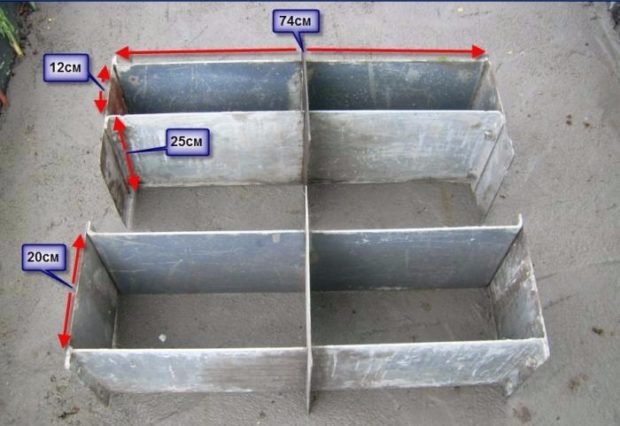 Try to make shapes with the most correct geometry.
Try to make shapes with the most correct geometry.
Preparation of cement-sand mortar
The process of preparing a sand-cement mixture is carried out according to the following algorithm:
- Clean the sand from impurities with a sieve.
- Weigh the required amount of Portland cement and sand.
- Load the ingredients into the mixer.
- Stir for 5 minutes until smooth.
Which foaming agent to use for foam concrete
The quality of the foaming agent affects the performance characteristics of the foam concrete. Various foaming agents are used:
- purchased, offered in specialized stores. They are a concentrate that is diluted to the required state according to the manufacturer's recommendations;
- self-made. The homemade foaming agent contains caustic soda in the amount of 0.15 kg, 0.06 kg of wood glue and a kilogram of rosin. The ingredients are mixed with slight heating until a uniform consistency, followed by the addition of water.
The self-prepared foaming agent is not inferior in quality to the finished concentrate.
We pour the ready-made foam concrete solution
The filling of the molding containers is carried out in different ways:
- manually with small volumes of foam concrete blocks production;
- using a concrete pump in the manufacture of blocks in industrial volumes.
Equipment and tools
When making foam blocks at home, you may need the following equipment and accessories:
- feeder for cement and sand;
- foam generator with a capacity of at least 200 l / min;
- baro installation;
- used water dispenser;
- vibrating screen (raw material sifter);
- ready mix outlet hose;
- compressor;
- concrete mixer with a volume of at least 250 liters;
- special forms for blocks or a cutting machine.
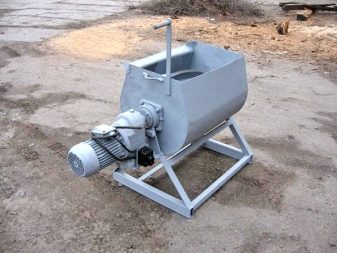
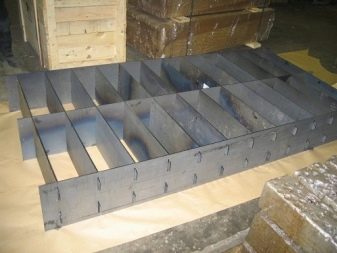
It will not be difficult to buy the necessary equipment for the production of building materials at home today. If desired, you can purchase not only a complete production line, but also its individual components. It is worth considering that equipment for the production of foam blocks at home is not only stationary, but also portable. The line can be conveyor or automated. These factors determine the cost of the purchased equipment.
At the heart of any set of equipment is a foam generator. Such a device per day can provide the release of about 100-110 cubic meters of material. A distinctive feature of stationary lines is their high productivity along with excellent quality and low cost. Considering that such a kit will cost about 1.5 million.rubles, this calls into question its purchase.
A mobile foam concrete plant does not require the purchase of an expensive foam generator, which makes it in demand in the construction market. However, along with this, it cannot boast of high performance. As a rule, in this case, a pressure setting is used, but with all its power, it is not capable of producing more than 40-45 cubic meters of finished material per day.
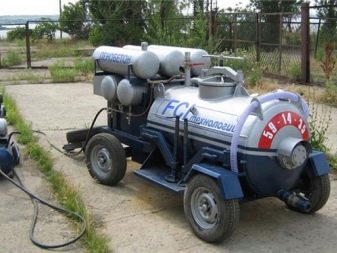

Their strength is inferior to analogs created on stationary lines. The price of a complete set for home production can vary from 50 to 300 thousand rubles. At the same time, as a rule, high-power equipment has a high cost. For example, a set for 300,000 rubles can give about 72 cubic meters of foam concrete per day.
An automatic line needs large areas, which is often problematic, because it was not provided initially. Typically, such lines require the creation of bins for cement, water, sand, as well as additives with automatic dosage. In addition, you need to think about the areas for drying foam concrete, pouring it into shapes, as well as installation for cutting. This equipment is capable of producing, on average, about 80-100 cubic meters of material per day, but not everyone can afford such a luxury, because the set will cost from 1.5 to 3 million rubles.
When at the initial stage there is not enough money, they buy used equipment. However, in this case, you should be prepared for the fact that some parts may need to be replaced quickly enough.


The forms purchased for foam concrete can be different. Today they are made from steel, plywood, and plastic. The capacity of products is different, for example, you can purchase plastic molds with dimensions of 390x190x288 mm, plywood options with dimensions of 588x300x188 mm, steel analogs with parameters 600x300x200 mm
When buying them, it is important to take into account the rigor of the geometry, since the quality of the finished material will directly depend on this. Even the slightest violation of symmetry is unacceptable
When choosing forms for pouring foam concrete mass, you should pay attention to the material of their manufacture
Considering that the formwork can be combined, this is especially important. For example, if the seller notes that the metal version with heavy-duty plastic inserts can withstand even the highest temperatures, you should not blindly trust this.
For example, if the seller notes that the metal version with heavy-duty plastic inserts is able to withstand even the highest temperatures, you should not blindly trust this.
The fact is that such forms are actually short-lived. In the process of drying and hardening of the foam concrete mass, a large amount of heat will be released.

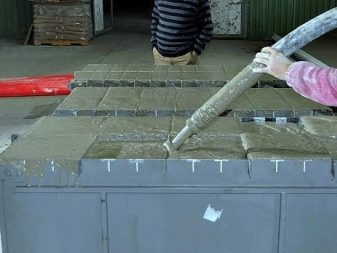
Business plan
The production of foam blocks as a business is a profitable and quite profitable occupation, since the demand for this material is constantly growing. However, it is still necessary to conduct an analysis of demand and competitiveness in a specific area in order to determine the number of potential buyers and the production volumes of existing enterprises.
If you plan to open a mini plant for the production of blocks, then you need to purchase special equipment, rent a room and create a business plan.
The area of the premises depends on the planned production volume. For example, for the production of 30 m3 of material per day, an area of 300 m2 is required.
Equipment for the production of foam blocks (minimum set, cost):
- concrete mixer (138,000 - 140,000 rubles);
- foam generator (23,000 - 27,000 rubles);
- compressor (about 37,000 rubles);
- 20 forms (6,000 - 7,000 rubles).
This means that the entire line for the production of foam concrete blocks will cost from 200,000 rubles.
If concrete is hardened in an autoclave, the price of the equipment will increase significantly
If a ready-made machine (installation) is purchased for production, it is important to choose the right supplier of this equipment.He should help with the installation and provide warranty service.
Profitability (expenses / income)
In addition to equipment, you will need a certain number of personnel, as well as the costs of general expenses (rent, electricity, water).
If you produce 30 m3 of foam concrete blocks per day, you will need:
- 9300-9600 kg of cement;
- 6300-6600 kg of sand;
- 3000-3300 l of water for cement mortar and 165-180 l of water for foaming agent;
- foam concentrate 45 l.
In monetary terms, this will amount to approximately 60,000 rubles plus 500 rubles for electricity.
The cost of the foam block also includes the cost of wages and rent. This means that the production of 30 m3 will cost about 66,000 rubles.
It is possible to sell 30 m3 of foam concrete blocks for 90,000 rubles and earn about 24,000 rubles on this.
If you produce 10 m3 each day and sell the products, then you can earn from 200,000 rubles a month. In this case, the initial costs will pay off in 1-2 months.
Stages of work
Interested in how to make foam concrete at home, you need to carefully study the technology for making foam blocks and find the best recipe. After that, you can step by step perform the required actions, strictly following the instructions.
Foaming agent solution
Foam concrete technology provides for the preparation of cement mortar. It is created in the same way as for traditional concrete. It is recommended to use products under the M400 or M500 brands as a cement mixture.
It is important to make sure that the sand is dry and free of unnecessary impurities or additives. To dilute the components, simple water from a centralized water supply system is used .. Foam is added to the finished solution.
The foam generator is sold in every hardware store or made from improvised means
Foam is added to the finished solution. The foam generator is sold in every hardware store or made from improvised means.

Pouring solution into molds
The next step is to pour the prepared consistency into prepared forms. Before performing this action, the containers are lubricated with a special solution. Builders know 2 methods of how to make foam blocks with their own hands:
- Injection molding.
- Cutting.
The first technology consists in pouring the solution into the workpieces. When it hardens, you can take it out of the mold and wait a couple more hours for final hardening. The use of this technique has several disadvantages. First of all, this is possible damage to the metal, and also the deformation of the blocks during removal.
It is quite difficult to install structures with uneven geometry, while they are of poor quality and not strong enough. However, the cutting method is more costly as it requires the purchase of special equipment.
Cutting technology
Production using cutting technology involves dividing the finished board into several separate sections. Within 6-9 hours, the raw materials acquire the optimum degree of strength and can be removed from the formwork. Then the prepared mass is moved by the traverse to the cutting equipment, and the specialist starts the cutting process.

The advantage of this technique is the highest accuracy, since the permissible deviation does not exceed 1 mm. The cutting complex is equipped with a special screw for removing the top and twisted strings that cut the material. To obtain different block sizes, the specialist changes the position of the cutting strings. 1 cycle lasts for 5-7 minutes.
After the end of the event, the container with the blocks is placed in a place to dry. Already after 12-24 hours, depending on the efficiency of drying, the foam block is taken out of the pallet and moved to the storage location.
The technique has the following advantages:
- The geometry of the blocks turns out to be even and correct.
- The edges have no deviations.
- Any chips and irregularities are excluded.
The disadvantages include:
- Additional costs for the purchase of equipment.
- If the concrete does not harden, it will collapse when cutting.
Factory production of foam concrete products: manufacturing features and profitability
The production of foam concrete blocks is a profitable business, which is why the idea of their production attracts the attention of not only economical land owners, but also interested businessmen. Foam concrete production scheme
 Foam concrete production scheme
Foam concrete production scheme
Equipment selection
To organize a company for the production of foam concrete will require considerable costs. They are connected, first of all, with the purchase of equipment, lease of premises and with the purchase of the necessary raw materials.
- The minimum set of equipment includes: mixer, foam generator, molds for blocks, compressor, pump for foam concrete.
- The best option would be to purchase an automated installation. It almost completely excludes human intervention. The main advantages of using a comprehensive kit are speed and high quality. The price, of course, is much higher, but the result is also appropriate.
- The choice of a supplier should be approached with special responsibility. Partnering with companies that have a proven track record in the supply of manufacturing equipment can profoundly affect the future success of an organization.
To ensure full compliance with the technological process and storage conditions, the organization needs additional technical equipment and the availability of various equipment.
It includes:
- Warehouse room suitable for storing finished blocks;
- Pallets that meet the GOST requirements
- Equipment for heat treatment of foam concrete products;
- Automated bunker for cement and sand, capable of batching material filling;
- Conveyor for the supply of sand (belt);
- A place for storing sand, in which a certain temperature and humidity level must be maintained.
Types of production and technology
The main methods for the manufacture of foam concrete in the factory:
- Bar technology allows you to supply all the necessary components to the mixer under the influence of pressure. The components in the required dosage are mixed and a ready-made solution is supplied at the outlet, which is sent to the forms. In this case, the use of a foam generator is not required.
- Pore-cutting technology allows the process to be carried out directly on the construction site, since this method uses mobile mobile equipment. Foam is made in a steamiser, which feeds it through the line, and the finished mixture enters the molds through the hose.
- The classic technology, which was already mentioned above, is also used in production, but the process is more automated. This is the most popular method of all.
 Porizator on wheels
Porizator on wheels
Consider how the full cycle of the foam concrete manufacturing process proceeds using more modern technology than home-made installations. In this case, the operation of machines is basic and practically does not require human intervention.
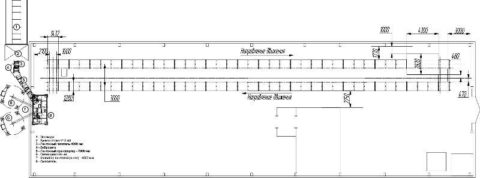 Automated line diagram
Automated line diagram
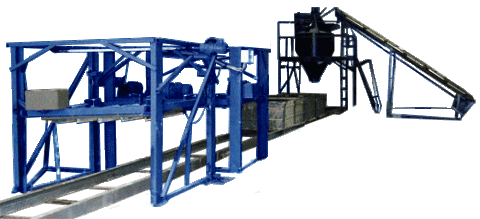 Modern line
Modern line
Brief instructions for the operation of an automated line:
- The operator starts the process of batching the material (cement, sand and water);
- The cement feeding auger automatically turns on and feeds it to the appropriate compartment. Feeding ends after dialing the required amount;
- Next comes the supply of sand by a belt conveyor, which is also fully automated by analogy with the auger;
- In parallel with these processes, a dose of water is collected and, when the required part is collected, bulk materials are unloaded;
- Foam is the last to enter the unit.
- The finished mixture is poured into molds and dries.
- After the expiration of the time required for gaining optimal strength, the mass is subjected to stripping and subsequent cutting.
The result of the production of foam concrete using such a line will meet all the requirements and quality indicators. The video in this article will demonstrate the general principle of such an installation.
 Band conveyer
Band conveyer
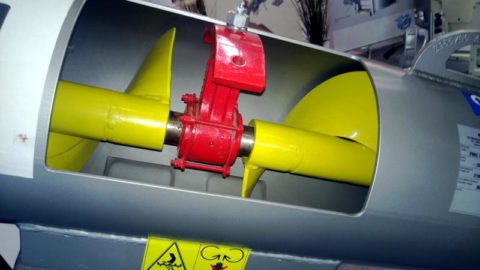 Cement auger
Cement auger
Foam concrete
Foam concrete products are a fairly young generation of environmentally friendly building materials, stepping on the heels of the older generation.
Now, since the 90s, the production and use of foam concrete has grown significantly in volume and is experiencing a real boom.
The material itself was invented and patented relatively recently - in 1924 by the Swedish architect A. Erickson. By historical standards, this is a short time.
Foam concrete products are made in the form of blocks, monoliths, using cutting or filling technologies, by autoclave and autoclave-free methods. In fact, this material can be given any shape.
Material characteristic
To correctly calculate the characteristics of the material, use the table No. 1 given here:
| View | Compressive strength | Medium density foam concrete grade | Coefficient of thermal conductivity |
| Thermal insulation wall contour | B 0.75 | D400 | 0,09–0,10 |
| B 1 | D500 | 0,10–0,12 | |
| Load-bearing and heat-insulating foam blocks | B 2.5 | D600 | 0,13–0,14 |
| B 3.5 | D700 | 0,15–0,18 | |
| B 5 | D800 | 0,18–0,21 | |
| B 7.5 | D1000 | 0,23–0,29 | |
| Load-bearing walls | B 10 | D1100 | 0,26–0,34 |
| B 12.5 | D1200 | 0,29–0,38 |
The use of foam concrete in the form of blocks or monoliths in the construction of construction objects made it possible to obtain properties that are unattainable when using other materials:
- Firstly, foam concrete is absolutely environmentally friendly, because of its porous structure it can be conditionally attributed to "breathing" materials, which contributes to the formation of a natural microclimate in a building (room).
- Secondly, it is heat (frost resistance) and sound insulation, the last of which is about 60 dB. If everything is clear with sound insulation, then there is something to add about thermal insulation. Thermal insulation in houses is adjustable due to the same porosity of foam concrete. Mold, mildew or fogging of glass in aerated concrete houses is an extremely rare occurrence. The air in the pores of the material serves as an additional pillow, prevents heat loss or, on the contrary, coolness, preventing the balance of internal and external temperatures.
- Thirdly, it is durability and fire safety due to the fire resistance of the material. With fire resistance, everything is also clear - it is achieved by the fact that foam blocks do not contain flammable materials, and therefore do not burn, melt, do not crack, and even at high temperatures keep their shape, do not lose strength and do not collapse. The durability of foam concrete is identical to ordinary concrete, which also gains strength over time. The durability of the material is associated with its high weather resistance and is explained by the low moisture absorption of the material.
- Fourthly, it is ergonomics and economy. Products made of foam concrete, subject to compliance with the requirements of state standards (GOST 12.1.007–76, GOST 25485–89 "Cellular concretes. Technical conditions"), according to the degree of exposure to the body of harmful substances (toxicological characteristics) belong to the non-hazardous category - low-hazard substances. In fact, this is a degree close to absolute environmental friendliness, which cannot be improved even if the porous surface of the blocks is filled with ecologically clean air of alpine meadows. Ergonomics and efficiency are due to the low cost of material or products made from it, size, weight. So, with an average block size (60cm x 30cm x 20cm), almost thirteen times the size of a regular brick (25cm x 12cm x 8.8 cm), its weight is only a little more than 23 kg. With the ratio of the volume of foam concrete to brick or wood (1 m³) - 1/1, foam concrete is cheaper than wood by an average of 30%, and brick by 40. A decrease in weight with an increased volume and permissible strength reduces the weight of the entire building, reduces the pressure on the foundation.
- And finally, fifthly, it is the ease of processing. This material is perfectly sawn, processed, and practically does not prick. No special or expensive equipment is required for processing. A regular hacksaw is fine.
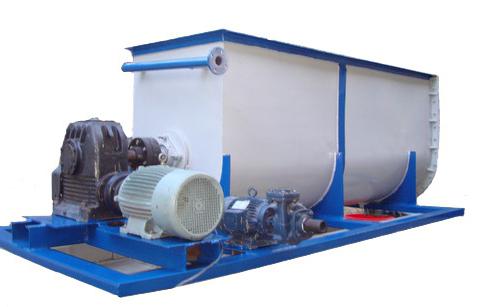
What are foam blocks
Foam concrete block is a concrete, clothed in a certain shape. How to make a foam block? For this you will need:
- cement;
- sand;
- foaming agent;
- water;
- equipment for obtaining a mixture;
- forms.
To obtain 1 m³ of finished blocks, approximately:
- 200 kg of building sand;
- 320 kg of cement PC 500 DO or grade not lower than M 400;
- 1-1.5 l of foaming agent;
- hardener;
- water on demand;
- electricity.
Diagram of a homemade foam generator.
In terms of money, this is much cheaper than buying blocks in a store. The most expensive component is cement. Its cost is approximately 75% of the cost of all received material. Additionally, you need to spend money on special equipment. It includes:
- foam generator;
- concrete mixer;
- compressor;
- manometers;
- forms.
Forms are very important in the manufacture of blocks. The dimensions of the finished blocks depend on them. For the construction of a bathhouse or garage, you can make foam blocks with your own hands measuring 50 x 20 x 20 cm.For the construction of the walls of a house, it is better to make the blocks wide 30 cm.All equipment can be bought, rented, made by yourself. Forms are quite simple to make from different sheet materials. Better to use metal sheets. It is necessary to make a large box and equip it with cells that have the dimensions of future blocks. These sizes can be any.
Forms and partitions can be made of 10 mm plywood. In this case, it is recommended to cover them with polyethylene so that the material of the mixture is not absorbed into the wood and the finished blocks can be easily removed from the cells. Huge sizes are not needed, in the form it is enough to have 40 cells. If you have 2 such forms in your work, the process of making blocks and installing walls from them can be done simultaneously. Finished blocks.
Pros and cons of adobe houses

Minuses:
- Not waterproof, afraid of even short-term flooding, must be protected from rain, equipped with increased slopes and cornices;
- Conducting construction only in the spring and summer in dry weather.
Pros:
- Environmental friendliness of materials;
- Cheapness and availability of material;
- Hygroscopicity, adobe structures are capable of absorbing and releasing moisture in greater quantities;
- The ability to store heat;
- The ability to build with your own hands and any design.
It is necessary to start building a house made of clay concrete by choosing a place. It is better to build such houses in a dry place on a hill or on a high foundation for fear of even short-term flooding.
It is advisable to start construction in the spring, so that it has time to dry well.

